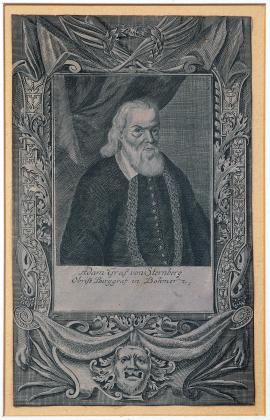
This square portrait depicts the the old-man down to his waist. His face is framed with white hair and a beard. He is wearing a dark cloak with many buttons. A massive chain is hanging around his neck. The rectangular field is richly decorated with frame ornaments.
Signature: Not available
Autor: Unknown
Original name: Adam Graf von Sternberg, Obrist Burggraf in Böhmen
The son of Zdenko and Catherine Řepická of Sudoěřice excelled in the brightness of spirit. He was a Sheriff of the New Town of Prague and later acted in various positions: in 1597-1599 as the High Judge of the Royal Court, in 1603 as the High Judge of the Land Court, in 1608 the High Chamberlain, and finally in 1618 as the High Burgrave of Prague. Though a faithful Catholic, he, as the Chancellor, signed in 1609 the Rudolf's Letter of Majesty, for which he was esteemed and respected throughout the country. He was the Lord of Jinín, Bechyně, Želeč, Libochovice, Plánice, Budyně, Krupka, Lnáře and Horaždovice. During the Defenestration of Prague he was allegedly led out of the defenestration hall by a mysterious friend, considerate of his advanced age and general esteem he enjoyed. Sternberg thus avoided the fate of his son-in-law Martinic, Lord Slavata and the Scribe Fabricius. He was also attending the session, where, after the Battle of White Mountain, Rudolf's Letter of Majesty was cut and its seal torn off. He was allegedly grieving and crying over the fate of his humbled country. He spent his last years in Bavaria, where he died on April 10, 1623. He was married twice – firstly to Eva of Lobkowicz a then to Maria Maxmiliano, Countess of Hohenzollern.
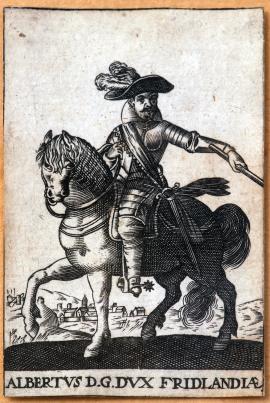
The small engraving portrays Wallenstein on a horseback. He has a hat with plumes on his head, his chest is covered with breastplate with an attached sash, and he is holding out his left hand with a marshal's baton. In the background there is a town with a high tower.
Signature: Not available
Autor: Unknown
Original name: Albertus D. G. dux Fridlandiae
Albrecht Václav Eusebius von Wallenstein, Duke of Friedland and Mecklenburg, Prince of Sagan, General of the Baltic Sea and Generalissimo of the imperial army was born in Heřmanice on September 24, 1583, and died in the murder of Cheb on February 25, 1634. Originally Utraquists, Wallenstein later converted to Catholicism. His first wife was Lucretia of Víckov, after whom he inherited large estates in Moravia. In 1617 he supported future Emperor Ferdinand II against the Venetians, became a colonel and was promoted to the rank of Imperial Counts. After the Czech Estates Uprising in 1618, Wallenstein sided with the Emperor and gained large estates (including Friedland) from confiscation proceedings. He managed to proliferate his vast fortune thanks to the exceptional talent for economy as well as to considerable ruthlessness and owing to plundering. In 1623 he married his second wife Isabella Katharina of Harrach, thus linking close contacts with the imperial court and clergy thanks to his father-in-law, the High Steward of Ferdinand II, and thanks to his brother-in-law Cardinal-Archbishop of Prague. He was using these contacts skilfully. In the war against the Danish King Christian IV, Wallenstein excelled extraordinarily by defeating Mansfeld at Dessau. His position at the imperial court was strengthening, but his thoughtless looting and completely arbitrary behaviour wherever he came, including even the lands of the Emperor's allies, soon gained him strong opposition too. His main opponent was Duke Maximilian of Bavaria, who managed to persuade the Emperor to remove Wallenstein from his posts at the Council of Prince-Electors in Regensburg in 1630. However, after the imperial army and the Catholic League suffered significant defeats by the Swedes (battles of Breitenfeld in 1631, of the Lech, etc.), the Emperor in distress called for Wallenstein again. This one took advantage of the situation and imposed tremendous conditions before accepting the rank of General again. His activities in this period could be characterized as permanent negotiating with various representatives of the enemy, ranging somewhere between interpretation of the Emperor's intentions and treacherous conspiracy. He was also achieving certain success on the battlefield, but obviously sabotaged any help to his ally (but the worst personal enemy) Elector Maximilian of Bavaria, who was badly pressed by the Swedes. He intended to seize the Czech throne, but his indecisiveness caused by prejudices of astrological nature kept preventing him from committing of the open act. The way he behaved raised suspicion of the Emperor that Wallenstein carries out treasonous activities and after a long hesitation finally conceded the execution of the Cheb, which took place on February 25, 1634. Wallenstein and his faithful companions were murdered there by imperial soldiers from Emperor's decision (which was: to bring him live or dead).
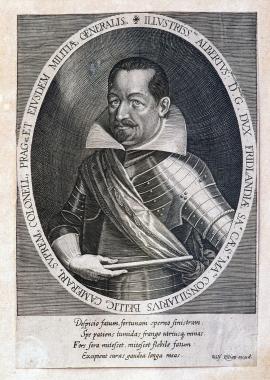
This oval portrait depicts the General staring towards the right side. His hair is cut relatively short, he has a moustache and a goatee. A wide white collar is lying on the top of his cuirass and a sash is attached across his right shoulder. He is holding a marshal's baton in his right hand. The inscription is situated around the ellipse. A Latin poem of four verses praising Duke for his bravery and power is inscribed under the portrait.
Signature: Wolf Kilian excud.
Autor: Killan Wolfgang, mědirytec
Original name: Ilustrissimus Albertus D. G. Dux Fridlandiae Sac. Caes. Majes. Consiliarius, Bellic, Camerari, supremus Collonellus Pragensis et eiusdem Militae Generalis.
Albrecht Václav Eusebius von Wallenstein, Duke of Friedland and Mecklenburg, Prince of Sagan, General of the Baltic Sea and Generalissimo of the imperial army was born in Heřmanice on September 24, 1583, and died in the murder of Cheb on February 25, 1634. Originally Utraquists, Wallenstein later converted to Catholicism. His first wife was Lucretia of Víckov, after whom he inherited large estates in Moravia. In 1617 he supported future Emperor Ferdinand II against the Venetians, became a colonel and was promoted to the rank of Imperial Counts. After the Czech Estates Uprising in 1618, Wallenstein sided with the Emperor and gained large estates (including Friedland) from confiscation proceedings. He managed to proliferate his vast fortune thanks to the exceptional talent for economy as well as to considerable ruthlessness and owing to plundering. In 1623 he married his second wife Isabella Katharina of Harrach, thus linking close contacts with the imperial court and clergy thanks to his father-in-law, the High Steward of Ferdinand II, and thanks to his brother-in-law Cardinal-Archbishop of Prague. He was using these contacts skilfully. In the war against the Danish King Christian IV, Wallenstein excelled extraordinarily by defeating Mansfeld at Dessau. His position at the imperial court was strengthening, but his thoughtless looting and completely arbitrary behaviour wherever he came, including even the lands of the Emperor's allies, soon gained him strong opposition too. His main opponent was Duke Maximilian of Bavaria, who managed to persuade the Emperor to remove Wallenstein from his posts at the Council of Prince-Electors in Regensburg in 1630. However, after the imperial army and the Catholic League suffered significant defeats by the Swedes (battles of Breitenfeld in 1631, of the Lech, etc.), the Emperor in distress called for Wallenstein again. This one took advantage of the situation and imposed tremendous conditions before accepting the rank of General again. His activities in this period could be characterized as permanent negotiating with various representatives of the enemy, ranging somewhere between interpretation of the Emperor's intentions and treacherous conspiracy. He was also achieving certain success on the battlefield, but obviously sabotaged any help to his ally (but the worst personal enemy) Elector Maximilian of Bavaria, who was badly pressed by the Swedes. He intended to seize the Czech throne, but his indecisiveness caused by prejudices of astrological nature kept preventing him from committing of the open act. The way he behaved raised suspicion of the Emperor that Wallenstein carries out treasonous activities and after a long hesitation finally conceded the execution of the Cheb, which took place on February 25, 1634. Wallenstein and his faithful companions were murdered there by imperial soldiers from Emperor's decision (which was: to bring him live or dead).
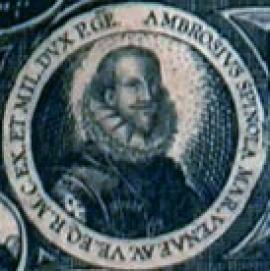
This small portrait depicts Spinola in a circular field surrounded with the above quoted Latin inscription in abbreviations and the Marquis's coat of arms by the side. The portrait forms the centre of a spiral composed of small oval pictures of all towns, fortresses and castles conquered by Spinola in Lower Palatinate between 1620 and 1621. General is portrayed down to his waist, slightly turned to the right, with fashionable goatee and moustache, and the typical collar in shape of a mill-stone.
Signature: Not available
Autor: Killan Wolfgang, mědirytec
Original name: Ambrosius Spinola Mar. Venae. Av. Ve. Eq. R. M. C. Ex. et Mil. Dux P. Ge.
Ambrosio, Marquis Spinola was born in Genoa in 1569 and died in Castelnuovo Scrivia (Piedmont) on September 25, 1630. In 1604 he conquered Ostend, which had been besieged since 1601. Then he fought against the Dutch under Maurice of Orange until conclusion of the 12-year truce in 1609. In the early years of the Thirty Years' War Spinola was sent by the King of Spain to Germany to support the Emperor and the Catholic League under Maximilian of Bavaria. In 1620 Spinola occupied Lower Palatinate, the land falling into the succession of the Czech King Frederick, Prince Palatinate, and in 1621 forced the Protestant Union to lay down and dispose of arms within the scope of so called Accord of Mainz. Once the truce between Spain and the Netherlands ended, Spinola once again turned against Maurice of Orange and conquered Breda in 1625. The National Gallery in Prague keeps in in its collections in the Sternberg Palace in Prague Castle a great portrait of Ambrosio, Marquis Spinola by Rubens.
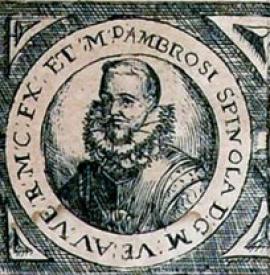
This small bust portrait depicts Spinola in a circular field surrounded with the Latin inscription literally quoted at the previous page. The General is staring towards the right side, has a typical wide collar and the Order of the Golden Fleece protruding underneath.
Signature: Not available
Autor: Killan Wolfgang, mědirytec
Original name: Ambrosi Spinola DG. M. Ve. AV. Ve. EQ. RMC. EX. ET M.
Ambrosio, Marquis Spinola was born in Genoa in 1569 and died in Castelnuovo Scrivia (Piedmont) on September 25, 1630. In 1604 he conquered Ostend, which had been besieged since 1601. Then he fought against the Dutch under Maurice of Orange until conclusion of the 12-year truce in 1609. In the early years of the Thirty Years' War Spinola was sent by the King of Spain to Germany to support the Emperor and the Catholic League under Maximilian of Bavaria. In 1620 Spinola occupied Lower Palatinate, the land falling into the succession of the Czech King Frederick, Prince Palatinate, and in 1621 forced the Protestant Union to lay down and dispose of arms within the scope of so called Accord of Mainz. Once the truce between Spain and the Netherlands ended, Spinola once again turned against Maurice of Orange and conquered Breda in 1625. The National Gallery in Prague keeps in in its collections in the Sternberg Palace in Prague Castle a great portrait of Ambrosio, Marquis Spinola by Rubens.
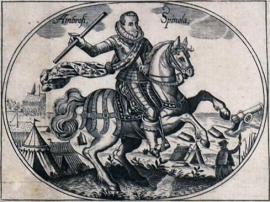
The portrait depicts the General on a horseback, holding a marshal's baton in his right hand. The horse is riding to the left side, the rider is bareheaded, dressed in cuirass and armour with a wide collar and a sash. The portrait is set in military surroundings with cannons, tents and camps, mustered soldiers, etc.
Signature: Not available
Autor: Killan Wolfgang, mědirytec
Original name: Ambrosius Spinola Mar. Venae.
Ambrosio, Marquis Spinola was born in Genoa in 1569 and died in Castelnuovo Scrivia (Piedmont) on September 25, 1630. In 1604 he conquered Ostend, which had been besieged since 1601. Then he fought against the Dutch under Maurice of Orange until conclusion of the 12-year truce in 1609. In the early years of the Thirty Years' War Spinola was sent by the King of Spain to Germany to support the Emperor and the Catholic League under Maximilian of Bavaria. In 1620 Spinola occupied Lower Palatinate, the land falling into the succession of the Czech King Frederick, Prince Palatinate, and in 1621 forced the Protestant Union to lay down and dispose of arms within the scope of so called Accord of Mainz. Once the truce between Spain and the Netherlands ended, Spinola once again turned against Maurice of Orange and conquered Breda in 1625. The National Gallery in Prague keeps in in its collections in the Sternberg Palace in Prague Castle a great portrait of Ambrosio, Marquis Spinola by Rubens.
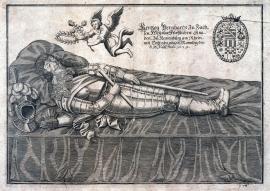
The engraving depicts Bernard, Duke of Saxe-Weimar, on his deathbed, clad in armour with a wide sash across his chest and with a lace collar around his neck. The Duke's helmet and iron gloves are lying beside. He is holding a marshal's baton in his right hand, while his left hand is resting on the hilt. An angel is hovering above the dead body, bringing laurel sprays and lilies. In the right corner we can see the coat of arms of Saxony-Weimar and the above mentioned inscription.
Signature: Not available
Autor: Killan Wolfgang, mědirytec
Original name: „Herzog Bernhards zu Sachsen Weymar Fürstlichen Gnaden. Zu Newenburg am Rhein mit Todt abgangen Montag den 8. / 18. Juli 1639.
Bernard, Duke of Saxe-Weimar, was born in Weimar on August 16, 1604, as the youngest son of John III of Saxe- Weimar. He fought in the battles of Wiesloch, Wimpfen and Stadtlohn between 1622-1623, he served as a colonel of the Danish King Christian IV and passed to the side of Gustavus Adolphus of Sweden in 1631. He excelled in the battles against Wallenstein nearby Nuremberg in 1632. In the Battle of Lützen of 16th November 1632 Bernard commanded the right wing of the Swedish army and after the death of the king took over the command of the entire army. The Swedish Chancellor Oxenstierna entrusted him with the command in southern Germany, thus enabling him to conquer Regensburg on 14th November 1633. In the battle of Nördlingen, where he fought by the side of Gustav Horn against Archduke Ferdinand (later Ferdinand III) and Matthias Gallas on September 6, 1634, Bernard suffered defeat. Later on, he concluded an agreement with Richelieu, binding him to enter into the French service and to withhold 18,000 men for French money. In exchange for his services he was promised to receive into his possession the Principality of Alsace and Hennegau (contract of St. Germain en Laie, dated 27th Oct. 1635). His troops fought with success in Lorraine during 1635-36 and crossed the Rhine in 1638. The imperial troops under the command of Werth and Savelli were defeated at Rheinfelden on 3rd March 1638 and Bernard conquered Brysach on 17th December of the same year, having previously repulsed counter-attacks of the imperial and Bavarian troops nearby Wittenweyer (on 4th August 1638 ) and by Thann in Sundgau (on 15th October 1638). When he was about to invade Bavaria and further hereditary lands of the Emperor, Bernard suddenly fell ill and died in Neuenburg in the Baden region on 18th July 1639. A widespread speculation that he had been poisoned by the French, was denied by several historical sources of evidence. In contradiction to Duke's last will, Richelieu earned the territory conquered by him and gained his army for France.
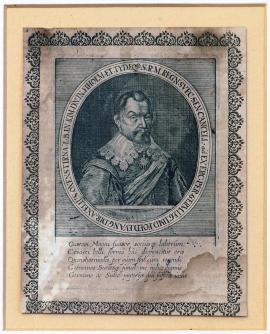
The bust portrait of Chancellor depicts him in an oval field, with a wide goatee and a discreet moustache; his hair is cut short. He is gazing slightly to the left. He wars a fashionable lace collar around his neck and his chest is girded with a sash and decorated with no doubt a Swedish order. The inscription quoted above is written around the oval. Five Latin verses opulently extolling the Chancellor's virtues are placed below the portrait.
Signature: Not available
Autor: Jode Peter de, mědirytec
Original name: Axelius Oxenstierna L. B. in Kim, Dn. in Finholm et Tydeo, S. R. M. Regn. svec. sen cancell. ad Exerc. per Germ. Leg. ibid. Foed. evang. Dir.
Count Axel Oxenstierna was born on a farm Fänö close to Upsala on June 26, 1583, and died in Stockholm on September 7, 1654. He studied the science of statesmanship and theology in Rostock, Wittenberg and Jena. In 1606 already he became the Swedish ambassador with the Mecklenburg court and a member of the Swedish Privy Council. In 1612 he was appointed by Gustavus Adolphus the Lord High Chancellor. In 1613 Oxenstierna concluded peace Treaty of Knäred with Denmark and in 1617 peace Treaty of Stolbow with Russia. Starting 1620 he participated in military campaigns of Gustavus Adolphus to Poland and in 1626 was appointed Governor-General of Prussia and concluded truce with Poland, which allowed Gustavus Adolphus hit Germany several times in the course of the Thirty Years' War. From 1631 he was the King's proxy in the Rhineland and after the King's death at Lützen took over political and military leadership. He managed to unite most of the Protestant princes around his political concept, however without those of Saxony and Brandenburg. After the defeat in the Battle of Nördlingen the new union broke down, primarily due to the Peace of Prague (1635) concluded by the Elector John George I with the Emperor. The Swedish Chancellor unsuccessfully attempted to persuade France to intensify its fight against the Emperor. France was too exposed in the struggle with Spain taking place at the same time, and therefore could not satisfy Oxenstierna's request. In 1636 the Chancellor took over the regency in place of Queen Christina of Sweden, but his voice dominated the Swedish home and foreign policy still after the Queen reached the age of majority. In 1645 Oxenstierna was personally involved in the negotiations with Denmark leading to the Treaty of Brömsebro. Axel Oxenstierna was not only the utmost statesman of Sweden, but also one of the most significant politicians ever. His administrative laws and reforms, as well as his foreign policy, are still recognized as the highlight of statecraft
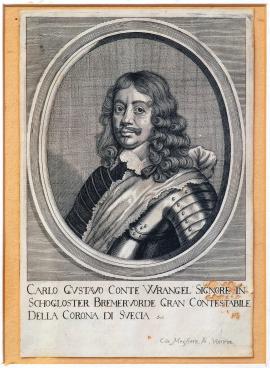
This bust portrait of the General depicts him looking to the right. He has got long curly hair, a moustache fashionably combed upwards and a typical pointed goatee. His relatively small collar is decorated with lace. His chest is covered with a cuirass and a sash. The inscription quoted above is placed below the oval portrait.
Signature: Corn. Meyssens. Fe. Viennae.
Autor: Meyssens Cornelius, vídeňský mědirytec
Original name: Carlo Gustavo conte Wrangel signore in Schogloster Bremervorde Gran contestable della corona di Svecia. etc.
Katalogová čísla:Collection Český Šternberk, kód: 503/263
Hans Wolfgang Singer – Allgemeiner Bildnisskatalog: 98581
Count Carl Gustaf Wrangel was born in 1613 and died in 1676. He first gained recognition in the Battle of Lech in 1632, in which Tilly got defeated and killed. In 1638 Wrangel was appointed Major-General. After Baner's death Wrangel along with two other generals became commander-in-chief of the Swedish army, but later ceded his command to Torstensson, under whom he then fought in Germany and Denmark. In 1644 he became the supreme commander of the Swedish fleet and defeated the Danes at Fehmer in the same year. In 1645 he was sent back to Germany as Armourer of Artillery and took over supreme command after Torstensson, who had to give it up due to illness. Together with the French commander Turenne, Wrangel defeated the imperial and Bavarian army at Zusmarshausen on May 7, 1648. After conclusion of the Peace of Westphalia he became Governor-General of Swedish Pomerania and since 1651 held the title of Count. In the war of Charles X against Poland, he was initially in command of the fleet, but later also fought on land. In the Battle of Warsaw in 1656, Wrangel held the command together with the Elector of Brandenburg over the left wing of the Swedish-Brandenburg army. Later he took command of the fleet once again, but was out of luck in front of Copenhagen. During the minority of Charles XI, Wrangel became the Reich Marshal and a member of the provisional government. Towards the end of his life he once more took part in the war, this time against Brandenburg, but owing to poor health had to hand over the command to his brother Waldemar. This one was nevertheless defeated by the “Great Elector” at Fehrbellin on 28 June 1675. During the Thirty Years' War, Wrangel managed to gather an immense booty and fortune, which he later used for the construction of various splendid buildings in Skoklostr and Stockholm.
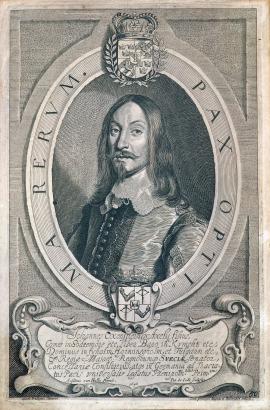
The bust portrait depicts a figure with long hair, slightly rolled moustache and small goatee, dressed in silk cloths with a lace collar. His face is turned slightly to the right. The slogan “Pax optima rerum” is inscribed around the oval. The Swedish royal coat of arms looped with laurel sprays is depicted above the portrait, while the Oxenstierna family coat of arms with the crown of leaves is placed in the bottom of the print. Latin explanatory text is inscribed in an abundantly decorated Baroque cartouche.
Signature: Anselmus van Hulle pinxit, Pet. de Jode sculpsit 1648. accesit privilegium caesaraeum. cum privilegio regum et Hollandiae ordinum
Autor: Hulle Anselmus van, nizozemský malíř
Original name: Johannes Oxenstierna Axelij filius, comes in Södremöre etc. liber Baro in Kymeth etc. Dominus in Fyholm, Hornunegholm et Tulgarn etc. S. Regiae Majestatis Regnorumque Sveciae senator, cancellariae consiliarius atque in Germania ad tractatus pacis universalis legatus plenipotenciarius primcius.
Katalogová čísla:Collection Český Šternberk, kód: 479/187
Hans Wolfgang Singer – Allgemeiner Bildnisskatalog: 69679
Count Johan Oxenstierna was the son of Axel Oxenstierna, Swedish statesman and Chancellor. He also studied the science of statesmanship and law, was the Swedish ambassador and plenipotentiary in the negotiations of the Peace of Westphalia in Osnabrück in 1648. Later he became a senator and a member of the Swedish Privy Counsel. He was born in 1611 and died in 1657.
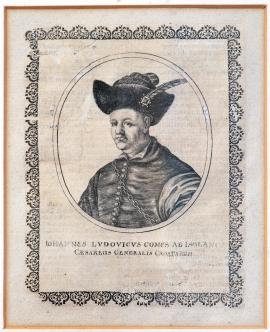
The General is portrayed down to his waist from his left profile, in an oval field set in a square frame decorated with rich ornamentation. He is wearing a fur cap with a long plume fixed thereto with an agraffe of gems. His coat is decorated with buttons, and a chain is stretching across his chest. The portrait has the most probably been taken from Abelin's “Theatrum Europaeum”.
Signature: Not available
Autor: Hulle Anselmus van, nizozemský malíř
Original name: Johannes Ludovicus comes ab Isolani, caesareus generalis croatarum.
Katalogová čísla:Collection Český Šternberk, kód: 465/344
Hans Wolfgang Singer – Allgemeiner Bildnisskatalog: 42668
Count Isolani was the Imperial Cavalry General for nearly the whole period of the Thirty Years' War. He was born in Görz in 1586 and died in Vienna in March of 1640. He already fought against the Turks in 1603. In 1632, he was appointed Cavalry Colonel of Wallenstein's army, consisting mostly of the Croatians. He excelled in many battles, particularly in the Battle of Lützen in 1632. The Emperor rewarded Isolani's martial merits as well as timely divergence from the treacherous Wallenstein, by bestowing him the title of Count and by awarding him the Czech manors of Frydštejn and Český Dub.
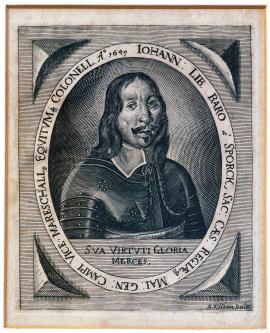
The bust portrait of the General is set in an oval field. He is dressed in armour, has black hair, a moustache, a small goatee and a distinct scar on his right cheek. The above quoted Latin inscription in abbreviations is inscribed around the portrait, while in the bottom of the artwork reads the slogan “Sua virtuti Gloria merces”. In the corners of the print there are small dark triangles.
Signature: Not available
Autor: Killan B., mědirytec
Original name: Johann Lib. Baro Sporck, Sac. Caes. Regiae. Mai. Gen. campi Vice Mareschallus Equitum Colonell Anno 1649.
Katalogová čísla:Collection Český Šternberk, kód: 489/25
Hans Wolfgang Singer – Allgemeiner Bildnisskatalog: 86725
Johann von Sporck came from a small farm in Westphalia, where he was born in Westerloh in 1595. He never learned to read or write. He was nevertheless well-built, tall, strong and very courageous, and therefore joined as an ordinary soldier the army of the Catholic League. He fought as soon as in 1620 in the Battle of White Mountain, where he excelled with his bravery and quick decision-making. Duke Maximilian of Bavaria appointed him colonel in 1637. He excelled in the battles of Bernburg in 1638 and 1641, in the battles of Dutling in 1643 and 1645 and, also, in the battle of Jankov, where he got injured. In 1647 Sporck was assisting the notorious John of Werth in his attempts to steal the troops of the Duke of Bavaria and take them to Bohemia to join the imperial service. The attempt nevertheless failed due to the resistance of the army. Sporck ran away and the Duke of Bavaria declared him traitor. He afterwards entered into the service of Ferdinand III, who appointed him a War Councillor, promoted him to General-Field Marshal-Lieutenant (Feldmarschall-lieutenant), appointed him to Supreme Commander of Cavalry, endowed him with estates and in 1647 gave him a noble title. In the same year Sporck fought against the Swedes in Bavaria, then changed the sides and fought with them in Poland and Schleswig. The victory at St. Gotthard in 1664 was credited primarily to him, whereupon he was given the title to a county of the Empire. As of 1658 Sporck was a devoted companion of General Montecucoli and accompanied him during all of his military campaigns. Sporck gained considerable fortune, which is why he was reminded by many envious people as someone who turned into a count and prince from a swineherd. He died on August 6, 1679, in Heřmanův Městec and is buried in Lysá nad Labem.
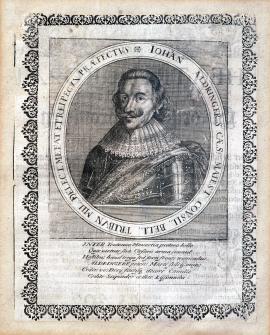
Oval bust; the portrayed figure is looking to the right, has medium-long hair, a moustache brushed up and a small beard. He is dressed in armour with a large sash and with a lace collar around his neck. The above mentioned inscription is placed around the oval. Under the depiction reads a poem of six verses, extolling the qualities of the portrayed lord. It is surrounded with a square ornamental frame.
Signature: Not available
Autor: Killan B., mědirytec
Original name: Johan Aldringer S. Caes. Majest. consil. Bell. tribun mil. deleci. Metat. et rei pecun. praefectus.
Katalogová čísla:Collection Český Šternberk, kód: 443/250
Hans Wolfgang Singer – Allgemeiner Bildnisskatalog: 1289
Count John of Aldringen was an imperial general. He was born in Diedenhofen (Thionville) on November 10, 1588, and died nearby Landshut on July 22, 1634. He started from scratch, assisting Wallenstein in the recruitment of troops in 1625 already. In 1626 he excelled in in the famous Battle of Dessau Bridge and was then promoted to the Count. In 1629 Aldringen participated in the conclusion of the Peace of Lübeck and in 1630 conquered Mantua. He was afterwards entrusted with the command of the imperial army that was supposed to help Maximilian, the Elector of Bavaria. In 1632 he became a field marshal. He was notorious for his greed and scheming nature; he got easily involved into a conspiracy against Wallenstein, though he largely owed his career to him. After Wallenstein's fall, Aldrigen shamelessly enriched himself from the confiscated estates. Soon after, he died in defence of Landshut against the Swedes (he drowned in the Isar river during the chaotic escape of the imperial troops, while being hit with two balls). His considerable wealth gained in looting was inherited by his sister, later married to Earl Clary. Their descendants still bear the name Clary-Aldringen.
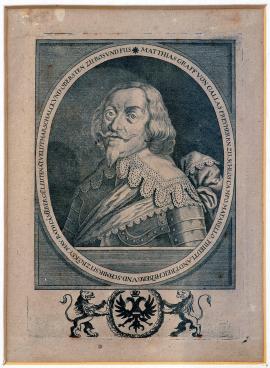
The General is portrayed in an oval field from the right profile, wearing armour with a sash across his right shoulder. He has a long hair, a goatee and a moustache combed upwards. His nose is markedly prominent. A blazon with the Imperial Eagle held by two lions is situated beneath the image. The aforementioned Latin inscription is placed around the oval. The engraving is unsigned.
Signature: Not available
Autor: Killan B., mědirytec
Original name: Mathias Graff von Gallas Freiherrn Schlos Campo Matarello, Friedlandt, Reichenberg und Schmirsitz, röm. kais. May. Rath, Cämmerer, Generalleutenandt, Feldtmarschalk und Obersten zu Ros und zu Fus.
Katalogová čísla:Collection Český Šternberk, kód: 461/20
Hans Wolfgang Singer – Allgemeiner Bildnisskatalog: 30686
Matthias Gallas, Count of Campo, Duke of Lucera, was an imperial commander in the Thirty Years' War. He was born in Trent on September 16, 1584 and died in Vienna on April 25, 1647. At first he served with the army of Spanish King in Flanders, later joined the forces of the Catholic League of Maximilian of Bavaria and excelled in the Battle of Stadtlohn in 1623 as well as in the War of Mantuan Succession taking place between 1628 and 1631. In the course of his service, Gallas was promoted to the rank of an Imperial Count. As a General he took over the command over the imperial army as of 1631 after the Battle of Breitenfeld. In 1634 he let himself involved into a conspiracy against Wallenstein and was appointed to the command of the imperial army. After the death of Wallenstein, Gallas received the Frýdlant estate confiscated from Wallenstein. Gallas was the most significant architect of the imperial victories over the Swedes in the early battles of Nördlingen in 1634. Later on he nevertheless mostly faced up to failures, especially in the fights against Torstensson, which gained him the nickname “destroyer of armies” (meaning his own armies). His lineage died out in the spear side in 1757. The property by marriage passed to the family of Clams, whose members name themselves Clam-Gallas to date.
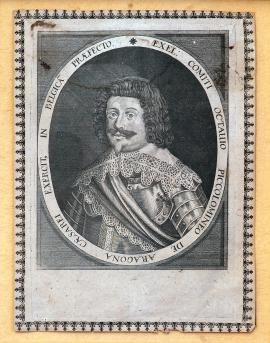
The bust portrait depicts Piccolomini in an oval field, staring straight forward. His head is covered with curly hair, he has got black moustache combed upwards and a small goatee. A wide lace collar lies on his cuirass and a sash traverses it. The oval is set into a proportionate rectangle, the corners of which are decorated with printer's ornaments. The portrait is the most probably taken from Merian's “Theatrum Europaeum”.
Signature: Not available
Autor: Killan B., mědirytec
Original name: Excel. comiti Octavio Piccolomineo de Aragona caesarei exercit. in Belgica. praefecto.
Katalogová čísla:Collection Český Šternberk, kód: 461/20
Hans Wolfgang Singer – Allgemeiner Bildnisskatalog: 30686
Count Ottavio Piccolomini was born in Florence on November 11, 1599 and died in Vienna on August 11, 1656. He first joined military forces in 1618 and served with the army of the Spanish Duke of Tuscany, to appear therewith in the Battle of White Mountain in 1620. In 1625 he became an imperial colonel and was accepted with the same rank to become commander of Wallenstein's personal guards. In 1632 he excelled in the Battle of Lützen, and was appointed by Wallenstein the General of cavalry. He earned Wallenstein's unlimited confidence and in January 1634 disclosed his traitorous intentions to the imperial court. He was leading the anti-Wallenstein conspiracy, which eventually ended up with the assassination in Cheb. For his merits in this delicate operation Piccolomini was appointed a Field Marshal, received the title of count and was endowed with estates in Náchod previously confiscated from the assassinated Wallenstein's companion Earl of Trcka. Piccolomini later participated in the Battle of Nördlingen, but the victory over the Swedes in the battle were credited to Gallas. Between 1635 and 1639 Piccolomini was fighting in the Netherlands in the service of the King of Spain, and from 1640 to 1642 in central Germany and Bohemia once again. The Emperor decorated him with the Order of the Golden Fleece in 1643, and endowed him with the Duchy of Amalfi. From 1644 to 1648 Piccolomini fought again in the Netherlands. At the end of the Thirty Years' War he served as the commander of the imperial troops in Bohemia. For his merits, both in the military and diplomatic sphere, which he won in 1649 thanks to his involvement in the negotiations on ratification of the Peace of Westphalia with the Swedes, the Emperor granted him in 1650 the hereditary title of count. He married Maria Benigna of Saxony-Lauenburg in 1651, but died childless five years later.
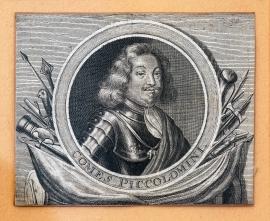
This is a small portrait in a round cartouche decorated with military emblems. The General's face is obese, with double chin, moustache and goatee. He has rather long curly hair. He wears a cuirass traversed with a sash and is decorated with the Order of the Golden Fleece.
Signature: Not available
Autor: Killan B., mědirytec
Original name: Comes Piccolomini.
Katalogová čísla:Collection Český Šternberk, kód: 461/20
Hans Wolfgang Singer – Allgemeiner Bildnisskatalog: 30686
Count Ottavio Piccolomini was born in Florence on November 11, 1599 and died in Vienna on August 11, 1656. He first joined military forces in 1618 and served with the army of the Spanish Duke of Tuscany, to appear therewith in the Battle of White Mountain in 1620. In 1625 he became an imperial colonel and was accepted with the same rank to become commander of Wallenstein's personal guards. In 1632 he excelled in the Battle of Lützen, and was appointed by Wallenstein the General of cavalry. He earned Wallenstein's unlimited confidence and in January 1634 disclosed his traitorous intentions to the imperial court. He was leading the anti-Wallenstein conspiracy, which eventually ended up with the assassination in Cheb. For his merits in this delicate operation Piccolomini was appointed a Field Marshal, received the title of count and was endowed with estates in Náchod previously confiscated from the assassinated Wallenstein's companion Earl of Trcka. Piccolomini later participated in the Battle of Nördlingen, but the victory over the Swedes in the battle were credited to Gallas. Between 1635 and 1639 Piccolomini was fighting in the Netherlands in the service of the King of Spain, and from 1640 to 1642 in central Germany and Bohemia once again. The Emperor decorated him with the Order of the Golden Fleece in 1643, and endowed him with the Duchy of Amalfi. From 1644 to 1648 Piccolomini fought again in the Netherlands. At the end of the Thirty Years' War he served as the commander of the imperial troops in Bohemia. For his merits, both in the military and diplomatic sphere, which he won in 1649 thanks to his involvement in the negotiations on ratification of the Peace of Westphalia with the Swedes, the Emperor granted him in 1650 the hereditary title of count. He married Maria Benigna of Saxony-Lauenburg in 1651, but died childless five years later.
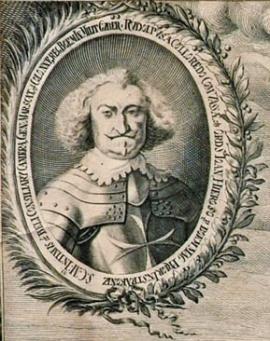
A bust portrait of Colloredo in an oval field. He is portrayed en face, with hair flowing down in waves, moustache combed upwards, and a goatee typical of the period. His chest is clad in armour decorated with the Order of the Maltese Cross. The oval field is framed by laurel and palm sprays. The portrait is situated in Merian's engraving, etched according to a drawing by Charles Skreta, depicting the siege of Prague by the Swedes under the command of Königsmark in 1648.
Signature: Not available
Autor: Killan B., mědirytec
Original name: Rudolfus a Colloredo Comuassae etc. Ordsionan Hierosop Bohemiag Prior in Strakonitz.
Katalogová čísla:Collection Český Šternberk, kód: 461/20
Hans Wolfgang Singer – Allgemeiner Bildnisskatalog: 30686
Count Rudolf Colloredo, was born on 2nd November 1585. He acted as Imperial Chamberlain and Field Marshal, and as the Commanding General in Bohemia, where he excelled in particular during the siege of Prague, when defending the town against the Swedes side by side with General Conti in 1648. He was the Grand Priory of the Sovereign Order of Malta in Bohemia. Colloredo died on 27th January 1657 and is buried in the Church of the Virgin Mary under the Chain in the Lesser Town of Prague, where the tomb with his statue of white marble can be found.
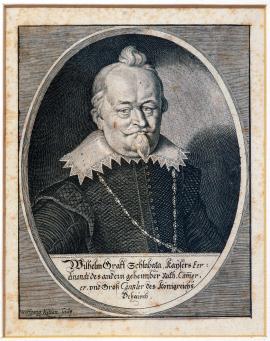
Slavata is portrayed in an oval field, with the above mentioned German text inscribed underneath. He is wearing a coat with numerous buttons and a wide collar, with a chain hanging around his neck. He has a pointed goatee and a rolled and combed-up moustache. Above his high forehead we can see his meticulously styled haircut.
Signature: Wolfgang Kilian sculp.
Autor: Killan Wolfgang, mědirytec
Original name: Wilhelm Graff Schlabata, Kaisers Ferdinandi des anderen geheimber Raath, Cämmerer und Gross-kantzler des Königreichs Beheimb.
Katalogová čísla:Collection Český Šternberk, kód: 461/20
Hans Wolfgang Singer – Allgemeiner Bildnisskatalog: 30686
Count (since 1621), Vilem Slavata of Chlum and Košumberk was a Czech statesman, who was born in Český Kostelec on December 1, 1572, and died in Vienna on January 19, 1652. He converted to the Catholicism, served as administrator of Rudolph II and became a member of the Vice-Regency of Bohemia established by Emperor Matthias in 1617. Along with Lord Regent Martinic and the scribe Fabricius he was involved in the Defenestration of Prague on May 23, 1618, when the revolting Czech non-Catholic estates threw them out of the windows of the Bohemian Chancellery at Prague Castle. However, except for small contusions, Slavata remained unhurt. At first he he was hiding in the house of Polyxena Lobkowicz, the wife of Supreme Chancellor Zdenko Adalbert, Prince of Lobkowicz, and then escaped to Bavaria. In 1620 he returned to his homeland and was abundantly rewarded by Ferdinand II. In 1628 he was appointed Chancellor of Bohemia. His annals were partially published by J. Jireček and A. Pezek in Prague in 1857-1868 and in 1887.
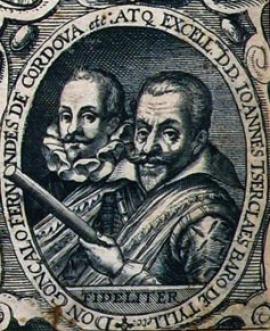
This is a bust portrait of Cordoba and Tilly in the depiction of the Battle of Wimpfen of 1622. Cordoba is looking to the right; he is wearing a high densely folded collar, with the hair cut relatively short, moustache and typical goatee. The inscription “Fideliter” is written below the portrayed commanders.
Signature: Not available
Autor: Killan Wolfgang, mědirytec
Original name: Goncalo Fernandes Don Cordoba
Katalogová čísla:Collection Český Šternberk, kód: 461/20
Hans Wolfgang Singer – Allgemeiner Bildnisskatalog: 30686
Gonzalo Fernandes de Cordoba, Prince of Maratra, was a Spanish general in the first half of the 17th century. In 1620 he served as junior commander in Spinolo's army marching to the Netherlands. It was then when Marquis Spinola sent him with the army to the Lower Palatinate, to conquer this hereditary land of the Czech 'Winter King' and to assist the Emperor Ferdinand II in the fight against the revolting Czech Estates. Cordoba clashed with Mansfeld in the Palatinate in 1621 and a year later won together with Tilly over the Margrave of Baden-Durlach nearby Wimpfen. Soon after that, Cordoba together with Tilly (again) defeated Christian, Duke of Brunswick-Wolfenbüttel, called “of Halberstadt”, in the Battle of Höchster. When he set to the journey in the pursuit of Mansfeld and Christian Brunswick, who moved up to the Netherlands to help Maurice of Orange, his troops managed to inflict significant losses to the Protestant army, nevertheless could not prevent strategically important alliance of the Protestant forces. As a governor of the Spanish King in Milan, Cordoba led the negotiations in the dispute for Valtellina between France and Spain since 1628, and won Monferrat in the War of the Mantuan succession. However, he was deposed soon after that for having abandoned prematurely the siege of the town and fortress of Casale. Later he reoccurred in the Netherlands, where he commanded Spanish troops in 1633.
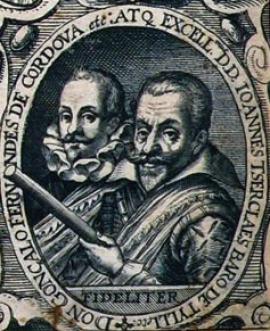
This is a bust portrait of Cordoba and Tilly in the depiction of the Battle of Wimpfen of 1622. Cordoba is looking to the right; he is wearing a high densely folded collar, with the hair cut relatively short, moustache and typical goatee. The inscription “Fideliter” is written below the portrayed commanders.
Signature: Not available
Autor: Killan Wolfgang, mědirytec
Original name: Goncalo Fernandes Don Cordoba
Katalogová čísla:Collection Český Šternberk, kód: 461/20
Hans Wolfgang Singer – Allgemeiner Bildnisskatalog: 30686
Gonzalo Fernandes de Cordoba, Prince of Maratra, was a Spanish general in the first half of the 17th century. In 1620 he served as junior commander in Spinolo's army marching to the Netherlands. It was then when Marquis Spinola sent him with the army to the Lower Palatinate, to conquer this hereditary land of the Czech 'Winter King' and to assist the Emperor Ferdinand II in the fight against the revolting Czech Estates. Cordoba clashed with Mansfeld in the Palatinate in 1621 and a year later won together with Tilly over the Margrave of Baden-Durlach nearby Wimpfen. Soon after that, Cordoba together with Tilly (again) defeated Christian, Duke of Brunswick-Wolfenbüttel, called “of Halberstadt”, in the Battle of Höchster. When he set to the journey in the pursuit of Mansfeld and Christian Brunswick, who moved up to the Netherlands to help Maurice of Orange, his troops managed to inflict significant losses to the Protestant army, nevertheless could not prevent strategically important alliance of the Protestant forces. As a governor of the Spanish King in Milan, Cordoba led the negotiations in the dispute for Valtellina between France and Spain since 1628, and won Monferrat in the War of the Mantuan succession. However, he was deposed soon after that for having abandoned prematurely the siege of the town and fortress of Casale. Later he reoccurred in the Netherlands, where he commanded Spanish troops in 1633.
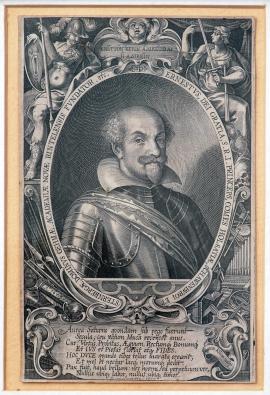
Ernst Holstein is portrayed en face in an oval field. His chest is covered with a breastplate crossed with a wide sash, he wears a soft collar open at the neck. He has a large bald spot on the head, but his hair around ears is rather long and curly; his moustache is combed up, accompanied with a pointed narrow goatee on the chin. Several military emblems, allegories of the arts and justice, etc. are depicted around the portrait. Above the oval there is a decorative cartouche with a Greek quote. In the bottom part of the artwork reads a Latin poem of eight verses extolling the virtues of the portrayed man. The entire graphic work is done extremely gently and reveals artistic mastery of the author.
Signature: Lucas Kilian sculps. Ao. 1623
Autor: Killan Lucas, mědirytec
Original name: Ernestus Dei gratia S. R. I. Princeps, Comes Holsatiae, Schawenburgi et Sternbergae, dominus Gehmae, academiae Rintelensis fundator etc.
Katalogová čísla:Collection Český Šternberk, kód: 463/383
Hans Wolfgang Singer – Allgemeiner Bildnisskatalog: 40766
Ernst, Count of Holstein, descended from a branch of the ruling house of Holstein. He was born in 1569 and died in 1622. Judging by this graphic artwork, he was a keen supporter of arts and sciences.
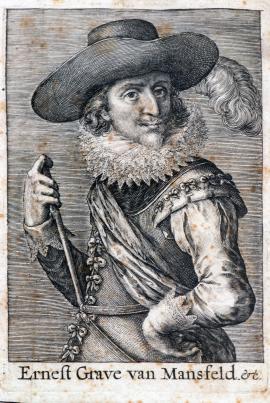
Mansfeld is portrayed in the small engraving together with Christian, Duke of Brunswick-Wolfenbüttel. The portrait by S de Passe (according to the signature) is etched with subtlety. Mansfeld is portrayed in a hat with a plume and a wide sash across the cuirass. He is holding marshal's baton in his right hand.
Signature: Not available
Autor: Killan Lucas, mědirytec
Original name: Ernest Grave ven Mansfeld
Katalogová čísla:Collection Český Šternberk, kód: 472/2
Hans Wolfgang Singer – Allgemeiner Bildnisskatalog: 58969
Ernst, Count of Mansfeld, was an illegitimate son of Peter I Ernst of Mansfeld. He was born in Luxembourg in 1580 and died in Rakovica by Sarajevo in Bosnia on November 29, 1626. From 1608 Mansfeld acted in the service of the Habsburg house, fought in Hungary and the Netherlands. In 1610 he nevertheless allied himself the Protestant Union, though remaining a Catholic by religion. At the beginning of the Thirty Years' War, he joined his troops with the forces of the Czech Estates, to conquer jointly the town of Pilsen. He was a Field Marshal of Frederick, Elector Palatine. In 1621 he was forced to retreat to the Upper Palatinate and from there marched on to the (Lower) Palatinate of the Rhine against the Spaniards under Marquis Spinola and Corduba. Later on he settled in Hegenau and attempted to create here for himself the centre of the new Principality. On 27th May 1622 his troops defeated Tilly at Mingolsheim. In spite of that he could not stay in the Palatinate any longer. He remained for some more time in the diplomatic and military service with Frederick, Elector Palatine, but was later dismissed together with Brunswick-Halberstadt and entered into the service of the Estates-General of the United Netherlands. In the Danish war he was defeated by Wallenstein in the Battle of Dessau on May 25, 1626. After this defeat he withdrew to the south to decoy Wallenstein away from the northern battlefield, to join the Prince of Transylvania, Gabriel Bethlen and, at the same time, to threaten the Emperor from the east. Bethlen nevertheless abandoned him and Mansfeld went further to the south to accomplish alliance of the Venetian Republic with the Protestant camp against the Emperor. On his way to Venice, Mansfeld fell ill and died in Rakovice in Bosnia. Before his death, he put on the armour and died in a standing position, held by two servants. He was a person of wild and reckless nature, an unscrupulous condottiero, as was quite frequent in the epoch.
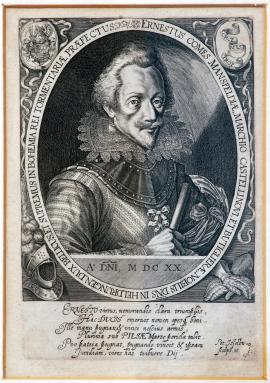
This small bust portrait depicts Mansfeld turned slightly to the right. He has an ascetic and lean face with a moustache fashionably combed upward and a small goatee, his hair is cut short. His wide collar is richly decorated with lace and his body is covered by a small cuirass. He is holding out a marshal's baton in his right hand. The oval field with his portrait is set into a rectangle with four motives in the corners: Mansfeld's coat of arms, ribbon with the inscription “Force m'est trop”, helmet and iron gloves. Beneath the portrait reads the year DNI. MDCXX. Six Latin verses extolling the General's virtues in superlatives are inscribed further below.
Signature: Pet. Isselburg sculps. et exc.
Autor: Isselburg Peter, mědirytec z Norimberka
Original name: Ernestus comes Mansfeldiae, marchio Castellinovi, et Butiglierae, nobolis dominus in Helderungen, dux bellicus et supremus in Bohemiae, rei tormentariae praefectus.
Katalogová čísla:Collection Český Šternberk, kód: 473/206
Hans Wolfgang Singer – Allgemeiner Bildnisskatalog: 58969
Ernst, Count of Mansfeld, was an illegitimate son of Peter I Ernst of Mansfeld. He was born in Luxembourg in 1580 and died in Rakovica by Sarajevo in Bosnia on November 29, 1626. From 1608 Mansfeld acted in the service of the Habsburg house, fought in Hungary and the Netherlands. In 1610 he nevertheless allied himself the Protestant Union, though remaining a Catholic by religion. At the beginning of the Thirty Years' War, he joined his troops with the forces of the Czech Estates, to conquer jointly the town of Pilsen. He was a Field Marshal of Frederick, Elector Palatine. In 1621 he was forced to retreat to the Upper Palatinate and from there marched on to the (Lower) Palatinate of the Rhine against the Spaniards under Marquis Spinola and Corduba. Later on he settled in Hegenau and attempted to create here for himself the centre of the new Principality. On 27th May 1622 his troops defeated Tilly at Mingolsheim. In spite of that he could not stay in the Palatinate any longer. He remained for some more time in the diplomatic and military service with Frederick, Elector Palatine, but was later dismissed together with Brunswick-Halberstadt and entered into the service of the Estates-General of the United Netherlands. In the Danish war he was defeated by Wallenstein in the Battle of Dessau on May 25, 1626. After this defeat he withdrew to the south to decoy Wallenstein away from the northern battlefield, to join the Prince of Transylvania, Gabriel Bethlen and, at the same time, to threaten the Emperor from the east. Bethlen nevertheless abandoned him and Mansfeld went further to the south to accomplish alliance of the Venetian Republic with the Protestant camp against the Emperor. On his way to Venice, Mansfeld fell ill and died in Rakovice in Bosnia. Before his death, he put on the armour and died in a standing position, held by two servants. He was a person of wild and reckless nature, an unscrupulous condottiero, as was quite frequent in the epoch.
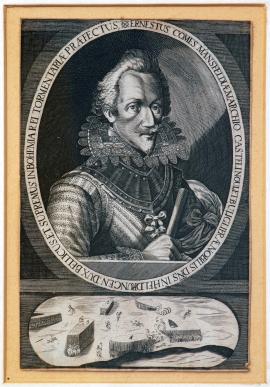
This bust portrait depicts Mansfeld with a lace collar, pointed goatee, rolled moustache and hair combed high. The General is holding a marshal's baton. In the background there is a rather amateurish depiction of a battle.
Signature: Not available
Autor: Isselburg Peter, mědirytec z Norimberka
Original name: Ernestus comes Mansfeldiae Marchio Castelinovi et Buliclierae Nobilis dominus in Heldrungen, Dux bellicus, et supremus in Bohemiae Rei Tormentariae praefectus.
Katalogová čísla:Collection Český Šternberk, kód: 474/14
Hans Wolfgang Singer – Allgemeiner Bildnisskatalog: 58977 a 58979
Ernst, Count of Mansfeld, was an illegitimate son of Peter I Ernst of Mansfeld. He was born in Luxembourg in 1580 and died in Rakovica by Sarajevo in Bosnia on November 29, 1626. From 1608 Mansfeld acted in the service of the Habsburg house, fought in Hungary and the Netherlands. In 1610 he nevertheless allied himself the Protestant Union, though remaining a Catholic by religion. At the beginning of the Thirty Years' War, he joined his troops with the forces of the Czech Estates, to conquer jointly the town of Pilsen. He was a Field Marshal of Frederick, Elector Palatine. In 1621 he was forced to retreat to the Upper Palatinate and from there marched on to the (Lower) Palatinate of the Rhine against the Spaniards under Marquis Spinola and Corduba. Later on he settled in Hegenau and attempted to create here for himself the centre of the new Principality. On 27th May 1622 his troops defeated Tilly at Mingolsheim. In spite of that he could not stay in the Palatinate any longer. He remained for some more time in the diplomatic and military service with Frederick, Elector Palatine, but was later dismissed together with Brunswick-Halberstadt and entered into the service of the Estates-General of the United Netherlands. In the Danish war he was defeated by Wallenstein in the Battle of Dessau on May 25, 1626. After this defeat he withdrew to the south to decoy Wallenstein away from the northern battlefield, to join the Prince of Transylvania, Gabriel Bethlen and, at the same time, to threaten the Emperor from the east. Bethlen nevertheless abandoned him and Mansfeld went further to the south to accomplish alliance of the Venetian Republic with the Protestant camp against the Emperor. On his way to Venice, Mansfeld fell ill and died in Rakovice in Bosnia. Before his death, he put on the armour and died in a standing position, held by two servants. He was a person of wild and reckless nature, an unscrupulous condottiero, as was quite frequent in the epoch.
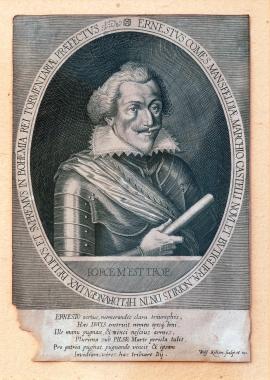
Signature: Not available
Autor: Isselburg Peter, mědirytec z Norimberka
Original name:
Katalogová čísla:Collection Český Šternberk, kód: 474/14
Hans Wolfgang Singer – Allgemeiner Bildnisskatalog: 58977 a 58979
Ernst, Count of Mansfeld, was an illegitimate son of Peter I Ernst of Mansfeld. He was born in Luxembourg in 1580 and died in Rakovica by Sarajevo in Bosnia on November 29, 1626. From 1608 Mansfeld acted in the service of the Habsburg house, fought in Hungary and the Netherlands. In 1610 he nevertheless allied himself the Protestant Union, though remaining a Catholic by religion. At the beginning of the Thirty Years' War, he joined his troops with the forces of the Czech Estates, to conquer jointly the town of Pilsen. He was a Field Marshal of Frederick, Elector Palatine. In 1621 he was forced to retreat to the Upper Palatinate and from there marched on to the (Lower) Palatinate of the Rhine against the Spaniards under Marquis Spinola and Corduba. Later on he settled in Hegenau and attempted to create here for himself the centre of the new Principality. On 27th May 1622 his troops defeated Tilly at Mingolsheim. In spite of that he could not stay in the Palatinate any longer. He remained for some more time in the diplomatic and military service with Frederick, Elector Palatine, but was later dismissed together with Brunswick-Halberstadt and entered into the service of the Estates-General of the United Netherlands. In the Danish war he was defeated by Wallenstein in the Battle of Dessau on May 25, 1626. After this defeat he withdrew to the south to decoy Wallenstein away from the northern battlefield, to join the Prince of Transylvania, Gabriel Bethlen and, at the same time, to threaten the Emperor from the east. Bethlen nevertheless abandoned him and Mansfeld went further to the south to accomplish alliance of the Venetian Republic with the Protestant camp against the Emperor. On his way to Venice, Mansfeld fell ill and died in Rakovice in Bosnia. Before his death, he put on the armour and died in a standing position, held by two servants. He was a person of wild and reckless nature, an unscrupulous condottiero, as was quite frequent in the epoch.
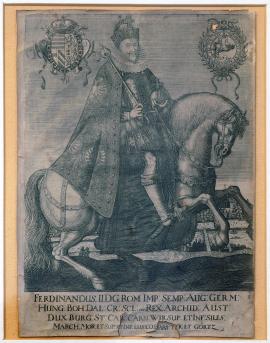
The portrait presents the Emperor Ferdinand II while riding a horse, dressed in the ceremonial imperial vestment. He is wearing an imperial crown on his head, and is holding a sceptre and an orb in his hands. A cloak is falling from his shoulders, with a typical costume of the period underneath and a wide collar (in the shape of a mill-stone) around his neck. In the top left part we can see the coat of arms of the Habsburg dynasty decorated with golden fleece, on the other side there is a laurel wreath with a hand holding the imperial crown protruding thereof, decorated with a ribbon saying “legitimate cetantibus“. Around the image reads: “coronatus in regem Romanorum IX. sept. MDCIX”. In the background, there is a depiction (mostly blurred) of a town – no doubt it is Frankfurt where Ferdinand II was crowned the Emperor. The above mentioned inscription is placed below the image.
Signature: Not available
Autor: Isselburg Peter, mědirytec z Norimberka
Original name: Ferdinandus II D. G. Rom. Imp. Aug. Germ. Hung. Boh. Dal. Cr. Scl. etc. Rex. Archid. Aust. Dux. Burg. St. Carn. Wir. Sup. et Inf. Siles. March. Mor. et Sup. et Inf. Lusco. Habs. Tyr. et Görtz.
Katalogová čísla:Collection Český Šternberk, kód: 457/179
Hans Wolfgang Singer – Allgemeiner Bildnisskatalog: 24393
Ferdinand II, Czech King and Roman Emperor between 1619 and 1637, the son of Charles, Archduke of Styria, was born in Graz on July 9, 1578, and died in Vienna on February 15, 1637. He was brought up by his mother Mary of Bavaria and educated by the Jesuits of Ingolstadt in strictly Catholic spirit, which remained the predominant guiding principle during his reign. At first, Ferdinand II started his Counter Reformation campaign in his hereditary lands to face considerable resistance there already. He attempted to do the same in Bohemia and Hungary, where he had been crowned in 1617 and 1618, but the non-Catholic Estates responded with an uprising, which initiated the outbreak of the Thirty Years' War. The Czech Estates Uprising was suppressed and the Protestantism was wiped out. When the war moved to Germany, the luck was at the Emperor's side especially thanks to the Wallenstein's large army of and to the alliance with the Elector Maximilian of Bavaria. The Spaniards helped him profusely in Lower Lusatia too. These achievements encouraged Ferdinand II to introduce so-called Edict of Restitution in 1629, which was going to organize the German religious situation in the Catholic sense. Despite the early death of his main opponent, the Swedish king Gustavus Adolphus, in the Battle of Lützen in 1632, despite the fall and assassination of Generalissimo Wallenstein in 1634 and the great victory in the Battle of Nördlingen in 1634, the Emperor overall could no stand up against the French and the Swedes. As to his capacities of a statesman, Ferdinand II was rather insignificant, dependent on his surroundings in each and every decision-making.
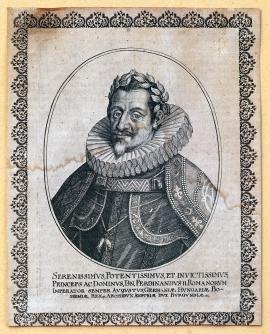
The Emperor is portrayed in an oval field from the left profile, wearing a laurel wreath on his head. He is dressed in armour, a long cloak falling from his shoulders, and with a wide Spanish collar around his neck. He is decorated with the Order of the Golden Fleece. The oval is framed with a square printer's ornament. The portrait is probably taken from the work of “Theatrum Europaeum” by M. Merian.
Signature: Not available
Autor: Isselburg Peter, mědirytec z Norimberka
Original name: Serenissimus potentissimus et invictissimus princeps ac dominus, Dn. Ferdinandus II. Romanorum imperator semper Augustus Germaniae, Hungariae, Bohemiae rex, archidux Austriae, dux Burgundiae.
Katalogová čísla:Collection Český Šternberk, kód: 458/213
Hans Wolfgang Singer – Allgemeiner Bildnisskatalog: 24417
Ferdinand II, Czech King and Roman Emperor between 1619 and 1637, the son of Charles, Archduke of Styria, was born in Graz on July 9, 1578, and died in Vienna on February 15, 1637. He was brought up by his mother Mary of Bavaria and educated by the Jesuits of Ingolstadt in strictly Catholic spirit, which remained the predominant guiding principle during his reign. At first, Ferdinand II started his Counter Reformation campaign in his hereditary lands to face considerable resistance there already. He attempted to do the same in Bohemia and Hungary, where he had been crowned in 1617 and 1618, but the non-Catholic Estates responded with an uprising, which initiated the outbreak of the Thirty Years' War. The Czech Estates Uprising was suppressed and the Protestantism was wiped out. When the war moved to Germany, the luck was at the Emperor's side especially thanks to the Wallenstein's large army of and to the alliance with the Elector Maximilian of Bavaria. The Spaniards helped him profusely in Lower Lusatia too. These achievements encouraged Ferdinand II to introduce so-called Edict of Restitution in 1629, which was going to organize the German religious situation in the Catholic sense. Despite the early death of his main opponent, the Swedish king Gustavus Adolphus, in the Battle of Lützen in 1632, despite the fall and assassination of Generalissimo Wallenstein in 1634 and the great victory in the Battle of Nördlingen in 1634, the Emperor overall could no stand up against the French and the Swedes. As to his capacities of a statesman, Ferdinand II was rather insignificant, dependent on his surroundings in each and every decision-making.
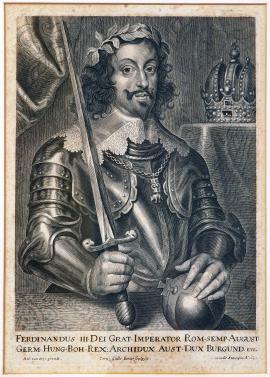
The Emperor is portrayed down to his waist. He is dressed in armour, holding a sword in his right hand, and his left hand resting on the Orb. He has a laurel wreath on his head. The Imperial Crown is lying on the table in the background.
Signature: Ant. van Dijck pinxit. Conr. Galla junior sculpsit.
Autor: Isselburg Peter, mědirytec z Norimberka
Original name: Ferdinandus III. Dei Grat. Imperator Rom. semp. August. Germ. Hung. Boh. Rex Archidux Aust. Dux Burgund etc.
Katalogová čísla:Collection Český Šternberk, kód: 459/7a
Hans Wolfgang Singer – Allgemeiner Bildnisskatalog: 24421
Ferdinand III was the son of Ferdinand II. He was born in Graz on July 13, 1608 and died in Vienna on April 2, 1657. His mother was Anna Maria, Princess of Bavaria. Ferdinand III reigned as the Holy Roman Emperor between 1637 and 1657, he was crowned Hungarian King in 1626 and the King of Bohemia a year later. He was a stubborn opponent of Wallenstein, brought up, like his father, by the Jesuits. His army under the command of Gallas won the significant Battle of Nördlingen in 1634. As a statesman, Ferdinand III continued the policy of his father, declared within the Peace of Prague in 1635. The influence of Spain, his refusal of compromising with the Austrian Protestants, his negative attitude to passing of certain lands of the Empire to foreign powers, as well as his disapproval with pardoning of the expelled insurgents, were the reasons why the Thirty Years' War protracted for such long time. As a personality he was very much like his father, but surpassed him in the level of education and brightness, which also manifested in his political prudence and foresight.
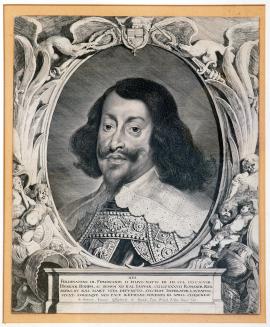
A monumental bust portrait. The figure is gazing to the right. His relatively long hair is parted above the right eye. His chest is covered with a decorated breastplate with the Order of the Golden Fleece. The collar is made of rich lace. The oval field is decorated with Baroque ornaments and the above-mentioned Latin text reads on a pilaster depicted in the bottom of the artwork.
Signature: P.Soutman invenit Effigiavit et excudit cum privil. P van Sompel sculp.
Autor: Soutman P., malíř
Original name: Ferdinandus III. Ferdinandi II. filius, natus III. jul. CIƆIƆCVIII. Hungar. Bohem ac demum XII. Kal. Januar CIƆIƆCXXXVII Romanor. Rex. Patri. XV. Kal. Mart. Vita defuncto. succedit imperator laudatissimus vivat, aureaque nos pace reficiat, vovemus id. April. CIƆIƆCXLIV.
Katalogová čísla:Collection Český Šternberk, kód: 460/247
Hans Wolfgang Singer – Allgemeiner Bildnisskatalog: 24428
Ferdinand III was the son of Ferdinand II. He was born in Graz on July 13, 1608 and died in Vienna on April 2, 1657. His mother was Anna Maria, Princess of Bavaria. Ferdinand III reigned as the Holy Roman Emperor between 1637 and 1657, he was crowned Hungarian King in 1626 and the King of Bohemia a year later. He was a stubborn opponent of Wallenstein, brought up, like his father, by the Jesuits. His army under the command of Gallas won the significant Battle of Nördlingen in 1634. As a statesman, Ferdinand III continued the policy of his father, declared within the Peace of Prague in 1635. The influence of Spain, his refusal of compromising with the Austrian Protestants, his negative attitude to passing of certain lands of the Empire to foreign powers, as well as his disapproval with pardoning of the expelled insurgents, were the reasons why the Thirty Years' War protracted for such long time. As a personality he was very much like his father, but surpassed him in the level of education and brightness, which also manifested in his political prudence and foresight.
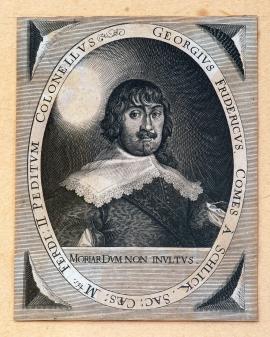
The portrait in an oval field depicts Schlick en face. His hair is falling down to his forehead, he has a wide moustache and a pointed goatee. He is wearing clothes with a wide lace collar. A Latin inscription “Moriar dum non inultus” is inscribed below the portrait. Four relief triangles are placed around the oval.
Signature: Not available
Autor: Soutman P., malíř
Original name: Georgius Fredericus comes a Schlick sac. caes Mtis. Ferdi. II. peditum colonellus.
Katalogová čísla:Collection Český Šternberk, kód: 460/247
Hans Wolfgang Singer – Allgemeiner Bildnisskatalog: 24428
George Frederick, Count of Schlick, lived in the first half of the 17th century and descended from the family line established by Lorenz Schlick. He was the son of John Ludwig and Adriana of Steinbeck. As many other men in his family, George Frederick also pursued military carreer and was appointed a governor in Landsberg in 1634. He died without descendents, like his brother Christopher Melchior. The engraver Elias Widemann of Agsburg preserved Schlick's portrait under No. 79 in his work called “Commitum gloriam centum sanguine qua, qua Virtute Illustrium” published in 1646, with a brief Latin inscription as shown on the previous page and with a slogan reading “moriar dum non inultus”.
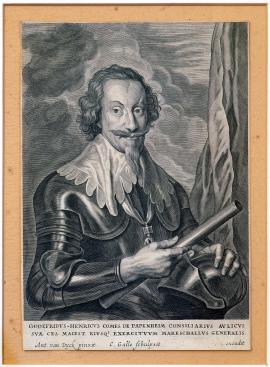
The portrait depicts the General down to his waist. He has got a long beard and his moustache is fashionably combed upwards. His wide collar is cut out. The General's chest is decorated with the Order of the Golden Fleece, his right hand is holding out a marshal's baton and his left hand is resting on a helmet. The whole concept of the portrait reveals experience, taste and mastery of the famous artist. The engraver's technique is worthy of the brilliant draft too.
Signature: Ant. van Dyck pinxit. C. Galle sculpsit.
Autor: Galle Conrad junior, holandský mědirytec
Original name: Godefridus Henricus comes de Papenheeim consiliarius aulicus suae ces. Maiest. eusque exercitum mareschallus generalis.
Katalogová čísla:Collection Český Šternberk, kód: 480/112
Hans Wolfgang Singer – Allgemeiner Bildnisskatalog: 70177
Gottfried Heinrich Graf zu Pappenheim was born in Pappenheim on the Altmühl on May 29, 1594. The son of the Protestant parents converted to the Catholic faith in the age of twenty. At first he served in the army of King Sigismund of Poland and later in the army of the Catholic League under Maximilian of Bavaria. He excelled for the first time, and was also wounded for the first time, in the Battle of White Mountain. In 1623 he joined the imperial army as a commander of the regiment of cuirassiers, and became notorious for his vigour throughout the whole army. He was fighting in Lombardy from 1623 to 1625, suppressed a peasant rebellion in Upper Austria in 1626, contributed Tilly in winning the war with Denmark and had major share in the conquest of Magdeburg in 1631. In the same year he inflicted a defeat of the imperial troops at Breitenfeld by leading his cuirassiers to the attack too early (note of editor: this is rather misleading notion as the Pappenheim's cuirassiers attacked 7 times in total; Gustavus Adolphus nevertheless deployed for the first time the formations of musketeers amongst the cavalry, who were mostly averting the attacks of cuirassiers). Later on he fought with success in Lower Rhineland and in Westphalia. In 1632 Pappenheim helped Wallenstein with the conquest of Leipzig and struck decisively in the Battle of Lützen on 16th November 1632 in the moment, where the situation became critical for the imperial army. He received mortal wound in this battle and died the next day in Pleissenburg near Leipzig. He was extremely popular amongst the members of his regiment of cuirassiers. They nicknamed him “Schrammenheinz” for plenty of scars from injuries suffered in combat all over his body. The well-known saying “I know my fellow Pappenheims!' has survived in German to date. It was derived from the proverbial fighting spirit of the Pappenheim's cuirassier regiment.
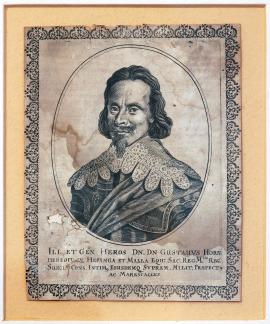
This graphic print portrays Gustav Karlsson Horn in an oval field. The edging of the square print is decorated with ornamentation. The General has a long hair, a typical moustache and a goatee, a wide cut-out collar and a cuirass with a wide sash. It is a bust portrait with the head turned slightly to the right. The literally quoted Latin text is placed below the portrait.
Signature: Not available
Autor: Galle Conrad junior, holandský mědirytec
Original name: Ill. et. Gen. Heros Dn. Dn. Gustavus Horn Heredit. in Heringa et Malla Equ. Sac. Reg. Mtis. Reg. Sveciae Cons. Intimus. Eiusdemo Suprem. Milit. Praefectus ac Marschallus.
Katalogová čísla:Collection Český Šternberk, kód: 464/145
Hans Wolfgang Singer – Allgemeiner Bildnisskatalog: 41205
Count Gustav Karlsson Horn was born on October 22, 1592 in Oerbyhus (Uppland) and died in Skara on May 10, 1657. He was appointed a member of the Royal Council in 1625 and the Field Marshal and Commander in Finland in 1628. During the war led by Gustavus Adolphus in Germany (since 1630), Horn was a member of the High Command and led the left wing of the Swedish Army to the victory in the Battle of Breitenfeld (September 17, 1631). After the king's death in the Battle of Lützen, Horn supported strategy of his father-in-law, Chancellor Oxenstierna. Later on in Swabia, he became an ally of Duke Bernard of Saxe-Weimar, who he was crushingly defeated with by the Imperial troops in the Battle of Nördlingen on 6th September 1634. He he was taken captive in here, to be nevertheless later released in an exchange, and in 1644 led his troops again to Schonen, where he forced the Danes to conclude the Peace Treaty of Brömsebro.
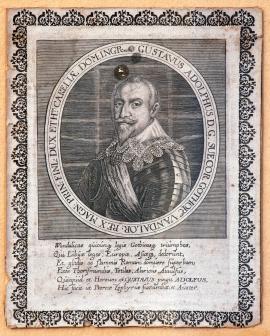
This portrait of Gustavus Adolphus depicts him dressed in cuirass with a wide sash, wearing a wide lace collar and a wrap. The aforementioned Latin inscription is written around the portrait. The edges of the square print are decorated with printer's ornamentation. Five Latin verses extolling the King's virtues are inscribed under the depiction.
Signature: Not available
Autor: Galle Conrad junior, holandský mědirytec
Original name: Gustavus Adolphus D. G. Suecorum, Gothorum, Vandalorum Rex. Magn. Prin. Finl. Eth. Careliae Dom. Ingr.
Katalogová čísla:Collection Český Šternberk, kód: 464/145
Hans Wolfgang Singer – Allgemeiner Bildnisskatalog: 41205
Gustavus Adolphus, King of Sweden, was a son of Charles IX and Christina of Holstein. He was born in Stockholm on November 6, 1594, and was killed in the Battle of Lützen on November 6, 1632. Gustavus Adolphus ascended the throne in 1611, when he also appointed Axel Oxenstierna the Chancellor of the Empire. He engaged in war with Denmark, Russia and Poland, and regained the territory conquered by the Danes against indemnification based on the terms of the Peace Treaty of Knäred in 1613. After his victory over Russia, Gustavus Adolphus regained Keksholmlän and Ingermanland in 1617. In the fight against the Poles achieved a truce keeping Lievland 1629. In the clash with the Poles he managed to keep Lievland for Sweden thanks to the truce declared in 1629. Religious conflicts in Central Europe and the fear from the imperial expansionism urged him to set up for a campaign to Germany in the support of the Protestant side. France supported the campaign with subsidies. On July 4, 1631, Swedish army landed in Pomerania and after initial difficulties defeated the imperial troops and the troops of the Catholic League. On November 6, 1632, Gustavus Adolphus clashed with Wallenstein in the bloody Battle of Lützen, where he was killed. His body was transported by Duke Bernnard of Saxe-Weimar to Weissenfels and subsequently by his wife Maria Eleonora, the sister of George Wilhelm of Brandenburg, to Sweden.
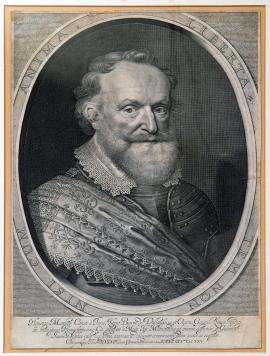
The bust portrait in an oval field subtly and masterfully depicts Thurn with a beard, dressed in armour and with an embroidered sash across his right shoulder. The inscription “Libertatem non nisi cum anima“ is written around the oval. An extensive Latin text is placed in the engraving bellow the portrait.
Signature: Cum privilegio Illuster. D. D. Ordinum Generalium annos octo. A. Dom. CI. I. CXXV (1625)
Autor: Galle Conrad junior, holandský mědirytec
Original name: Henrico Matthao Comiti a Turri, Libero Baroni de Vallesassina et Creutz, Generali Locum Tenenti, etc. hanc ipsius Herois fortissimo Co: effigiem á Mich. Joh. Miereveldio ad vivum depictum et Gulielmo Jacobi Delphio coelohac forma expressam, dedicant consecrantas idem pictor ac sculptor.
Katalogová čísla:Collection Český Šternberk, kód: 464/145
Hans Wolfgang Singer – Allgemeiner Bildnisskatalog: 41205
Heinrich Matthias, Count of Thurn-Valsassina, was one of the leaders of the non-Catholic Estates in Bohemia. He was born in Lipník v Čechách on February 24, 1567, he married to Elizabeth, Countess of Hardeck in 1618, and died in Pernau in Livonia on January 28, 1640. In 1609 he coerced Rudolf II into signing of the decree named Letter of Majesty and in 1611 was appointed Burgrave of Karlštejn Castle by Matthias. On May 23, 1618 the representatives of the rebellious Estates led by Count Thurn penetrated into the Bohemian Chancellor's Office and he himself threw the Lord Regent Slavata out the window. The Defenestration of Prague was the last and utmost impulse for the outbreak of war. In the fight against the Emperor, Thurn managed to bring his troops as far as to the gates of Vienna. After the Battle of White Mountain, Thurn escaped to Hungary. He later served in the Swedish army as the commander of a Swedish unit in Silesia, where he was forced by Wallenstein to surrender the fortress of Steinau an der Oder and was taken captive on October 10, 1633. He was nevertheless soon released again.
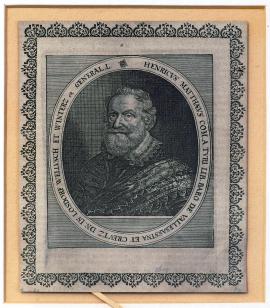
This oval portrait depicts the figure gazing to the right. Thurn's physiognomy is rendered according to the portrait by M. J. Miereveld No. 493/9. The oval is set into the square framing of printer's ornaments. The portrait is the most likely taken from the work “Theatrum Europaeum“.
Signature: Not available
Autor: Galle Conrad junior, holandský mědirytec
Original name: Henricus Mathaeus comes a Turi lib. Baro de Vallsassina et Creutz dn. in Losdorf, Wellusch et Winterz et General. L.
Katalogová čísla:Collection Český Šternberk, kód: 494/203
Hans Wolfgang Singer – Allgemeiner Bildnisskatalog: 90434
Heinrich Matthias, Count of Thurn-Valsassina, was one of the leaders of the non-Catholic Estates in Bohemia. He was born in Lipník v Čechách on February 24, 1567, he married to Elizabeth, Countess of Hardeck in 1618, and died in Pernau in Livonia on January 28, 1640. In 1609 he coerced Rudolf II into signing of the decree named Letter of Majesty and in 1611 was appointed Burgrave of Karlštejn Castle by Matthias. On May 23, 1618 the representatives of the rebellious Estates led by Count Thurn penetrated into the Bohemian Chancellor's Office and he himself threw the Lord Regent Slavata out the window. The Defenestration of Prague was the last and utmost impulse for the outbreak of war. In the fight against the Emperor, Thurn managed to bring his troops as far as to the gates of Vienna. After the Battle of White Mountain, Thurn escaped to Hungary. He later served in the Swedish army as the commander of a Swedish unit in Silesia, where he was forced by Wallenstein to surrender the fortress of Steinau an der Oder and was taken captive on October 10, 1633. He was nevertheless soon released again.
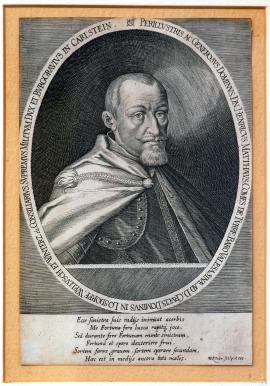
Thurn is portrayed from his left profile in an oval field. The aforementioned Latin inscription is written around the portrait in the print. The figure has relatively short haircut, a typical goatee and a rolled moustache, is dressed in cuirass partially concealed with a cloak hanging down from the shoulders. The wrap is attached with an interesting cord. A Latin poem of six verses extolling Thurn's virtues is placed bellow the portrait.
Signature: W. Kilian sculp. et exc.
Autor: Killan Wolfgang, mědirytec
Original name: Persilustris ac generosus Dominus, Dn. Henricus Mathaeus comes de Turre, Baro Valsasinae Ad D. Crucis Dominus in Losdorf, Wellusch et Winterz etc. Consiliarus, Supremus Militum Dux et Burgravius in Carlstein.
Katalogová čísla:Collection Český Šternberk, kód: 495/19
Hans Wolfgang Singer – Allgemeiner Bildnisskatalog: 90431
Heinrich Matthias, Count of Thurn-Valsassina, was one of the leaders of the non-Catholic Estates in Bohemia. He was born in Lipník v Čechách on February 24, 1567, he married to Elizabeth, Countess of Hardeck in 1618, and died in Pernau in Livonia on January 28, 1640. In 1609 he coerced Rudolf II into signing of the decree named Letter of Majesty and in 1611 was appointed Burgrave of Karlštejn Castle by Matthias. On May 23, 1618 the representatives of the rebellious Estates led by Count Thurn penetrated into the Bohemian Chancellor's Office and he himself threw the Lord Regent Slavata out the window. The Defenestration of Prague was the last and utmost impulse for the outbreak of war. In the fight against the Emperor, Thurn managed to bring his troops as far as to the gates of Vienna. After the Battle of White Mountain, Thurn escaped to Hungary. He later served in the Swedish army as the commander of a Swedish unit in Silesia, where he was forced by Wallenstein to surrender the fortress of Steinau an der Oder and was taken captive on October 10, 1633. He was nevertheless soon released again.
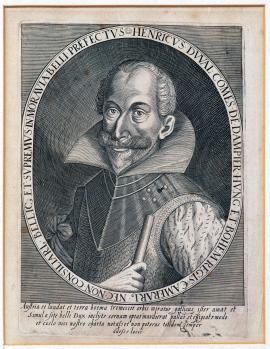
This oval portrait is surrounded with the above mentioned Latin text. In the bottom reads a long sentence (4 lines) extolling the General's virtues. Dampierre is dressed in a leather jacket, he is wearing a small cuirass around his neck and on his shoulders, the sleeves are embroidered and the collar is sticking out; his hair is cut relatively short, he has got pointed beard and moustache combed to the width. His nose is pointed and curved.
Signature: Not available
Autor: Killan Wolfgang, mědirytec
Original name: Henricus Duval Comes de Dampier, Hung. et Bohem. regis camerarius, nec non consiliarius bellicus et supremus in Moravia Belli Praefectus.
Katalogová čísla:Collection Český Šternberk, kód: 455/23
Hans Wolfgang Singer – Allgemeiner Bildnisskatalog: 18105
Henry Duval, Count of Dampierre, was a General of the imperial army. He was born at the Chateau du Hans in the diocese of Metz. He served under Basta against the Turks, defeated Gabriel Bethlen in 1604, but was repulsed from Transylvania by Bočkaj. In 1605, Dampierre commanded the troops in Esztergom, but had to surrender the town to the Turks due to the mutiny of his own men. In 1617, the Emperor sent him to Bohemia in head 10,000 men to suppress local rebellion, but they were defeated by Thurn in the battles of Čáslav and Lomnica. As a result of this failure Dampierre had to hand over the command to Buquoy. He was transferred to Moravia with no luck either and therefore retreated to Austria. Here he helped effectively the Emperor, who was importuned by Viennese Protestants, doing so by sending Colonel Hilaire with 500 cavalrymen to protect Ferdinand. At the same time, Thurn was besieging Vienna, which is why the situation was so extremely critical for the Emperor. Dampierre returned to Bohemia that same year and side by side with Buquoy and Wallenstein defeated Mansfeld in the battle of Netolice. He was then entrusted with the campaign to the east against Bethlen, who he defeated nearby Lokházy. He was fatally struck by a bullet during the attack on Bratislava and died on 9th October, 1620.
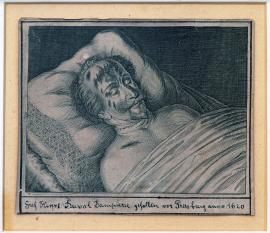
The portrait presents Dampierre lying in the deathbed. His head rests on the pillow, his body is exposed up to the breasts, the rest being covered with a blanket. The eyes of the dead are closed, several deep and bloody wounds can be seen in his forehead. Another large slash is on the right side of his clavicle. Clearly visible stitching on the neck of the dead general can be explained in the following way: when Dampierre died, his dead corpse was seized (while the battle was still underway) by the Hungarians of Bratislava, who then cut the head from the body and were showing it to the besieging imperial troops from the city walls. Only later, Gabriel Bethlen ordered to hand over the corpse of the fallen imperial general and the head was sewn to the body. A great funeral was held, which was even attended by the Emperor.
Signature: Not available
Autor: Killan Wolfgang, mědirytec
Original name: Graf Henry Duval Dampierre gefallen vor Presburg 1620.
Katalogová čísla:Collection Český Šternberk, kód: 456/16
Hans Wolfgang Singer – Allgemeiner Bildnisskatalog: 18106
Henry Duval, Count of Dampierre, was a General of the imperial army. He was born at the Chateau du Hans in the diocese of Metz. He served under Basta against the Turks, defeated Gabriel Bethlen in 1604, but was repulsed from Transylvania by Bočkaj. In 1605, Dampierre commanded the troops in Esztergom, but had to surrender the town to the Turks due to the mutiny of his own men. In 1617, the Emperor sent him to Bohemia in head 10,000 men to suppress local rebellion, but they were defeated by Thurn in the battles of Čáslav and Lomnica. As a result of this failure Dampierre had to hand over the command to Buquoy. He was transferred to Moravia with no luck either and therefore retreated to Austria. Here he helped effectively the Emperor, who was importuned by Viennese Protestants, doing so by sending Colonel Hilaire with 500 cavalrymen to protect Ferdinand. At the same time, Thurn was besieging Vienna, which is why the situation was so extremely critical for the Emperor. Dampierre returned to Bohemia that same year and side by side with Buquoy and Wallenstein defeated Mansfeld in the battle of Netolice. He was then entrusted with the campaign to the east against Bethlen, who he defeated nearby Lokháza. He was fatally struck by a bullet during the attack on Bratislava and died on 9th October, 1620.
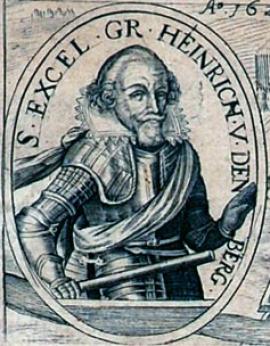
The portrait is oval shaped and the figure is portrayed to the waist from the right profile, clad in armour with a high lace collar. A wide sash is attached across the chest, the right hand waves with a marshal's baton. The beard style is typical for the 17th century, with the goatee and moustache brushed up. The portrait is included in the engraving depicting the siege of Gulch (Jülich) in the Netherlands.
Signature: Not available
Autor: Sadeler Marco, rytec
Original name: S. Excel. Gr. Heinrich von den Berg
Katalogová čísla:Collection Český Šternberk, kód: 456/16
Hans Wolfgang Singer – Allgemeiner Bildnisskatalog: 18106
Henry, Count of Berg was a Spanish general who besieged Jülich in 1621 (this event is depicted in the engraving where the described portrait is included). Count of Berg conquered Pfaffenmüntz Fortress in 1622, freed Gelsenkirchen from siege in the same year, and occupied Cleve in 1624. He was born in 1573 and died in 1638. He is mentioned in “Theatrum Europaeum”.
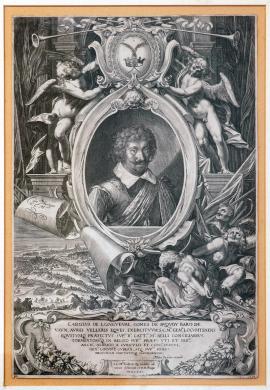
The general is portrayed in a small oval field, with curly hair, wide moustache, a simple white collar around his neck adorned with the Order of the Golden Fleece, and with a decorative sash attached across his left arm. The portrait is surrounded by rich allegorical drawings. At the top there is a small cartouche with a crown and two palm sprays, with an inscription 'Ex utraque gloria' in between them. In the background we can see the scene of the Battle of White Mountain.
Signature: Marco Sadeler excudit S. C. M. sculptor Eg. Sadeler ad vivum delineavit et D. D. Pragae M. D. C. X. X. I.
Autor: Sadeler Egydius, rytec a malíř v Praze
Original name: „Carolus de Longueval comes de Buquoy, baro de Vaux, aurei valleris eques, exercitum S. C. M. Gen. Locumtenens Equitumque Prefectus, supremus Rae. Cattcae Mtis Belli Consiliarius. Tormentorumque in Belgio Supremus prefectus uti et serenissimi Arch. Alberto a cubiculis et consuliis status, generalis locumtentis gubernio atque supremus praefectus provinciae comitatusque Hannoniensis“.
Katalogová čísla:Collection Český Šternberk, kód: 456/16
Hans Wolfgang Singer – Allgemeiner Bildnisskatalog: 18106
Charles Bonaventure de Longueval, Count of Buquoy, was born in Arras on 9th January 1571. At first he was fighting in the service of the Spaniards against the Dutch. In 1613 he became the governor of Hennegau. In 1618 he entered into the service of the Emperor and was entrusted with the supreme command over the imperial troops. Initially, he did not get much success in Bohemia, where the uprising of the estates broke out, he nevertheless defended successfully with his limited army Austria against Thurn leading the insurgent Czechs as well as against incursions of Gabriel Bethlen from the east. Together with Maximilian of Bavaria and with Tilly he finally won the Battle of White Mountain on 8th November 1620. After a short delay in the defeated Prague in order to heal his wounds, he moved forward to the east against Gabriel Bethlen and was killed nearby Nové Zámky in Slovakia on 10th July 1621.
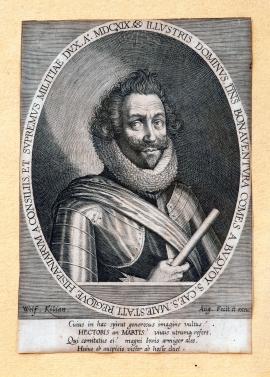
A bust portrait of Charles Bonaventure de Longueval, Count of Buquoy. The general is clad in armour and is holding a marshal's baton in his right hand. He has got a sash attached across his chest. He is looking slightly to the right, even though his face is directed to the left. His moustache is brushed upwards in the style of the period and his goatee forms a sharp point. The mentioned inscription is placed around the oval. Under the picture there are the four Latin verses praising the depicted general.
Signature: Wolf Killian Aug. Fecit et excu.
Autor: Killan Wolfgang, mědirytec
Original name: Illustris Dominus Dominus Bonaventura comes a Buquoy S. Caes. Majestati Regioque Hispaniorum a consiliis et supremus Militiae Dux. Anno MDCXIX.
Katalogová čísla:Collection Český Šternberk, kód: 449/186
Hans Wolfgang Singer – Allgemeiner Bildnisskatalog: 10620
Charles Bonaventure de Longueval, Count of Buquoy, was born in Arras on 9th January 1571. At first he was fighting in the service of the Spaniards against the Dutch. In 1613 he became the governor of Hennegau. In 1618 he entered into the service of the Emperor and was entrusted with the supreme command over the imperial troops. Initially, he did not get much success in Bohemia, where the uprising of the estates broke out, he nevertheless defended successfully with his limited army Austria against Thurn leading the insurgent Czechs as well as against incursions of Gabriel Bethlen from the east. Together with Maximilian of Bavaria and with Tilly he finally won the Battle of White Mountain on 8th November 1620. After a short delay in the defeated Prague in order to heal his wounds, he moved forward to the east against Gabriel Bethlen and was killed nearby Nové Zámky in Slovakia on 10th July 1621.
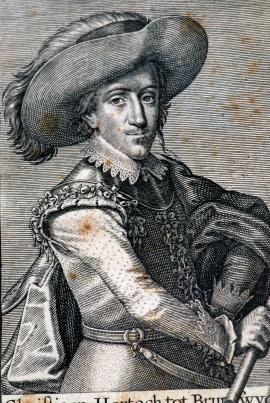
Christian of Brunswick is portrayed together with General Ernst Mansfeld in the engraving No. 76/2. He is wearing a wide hat with plume, holding a marshal's baton in his hand and a cloak is falling down from his left shoulder. The portrait is engraved with finesse and in detail; the etching is signed S.P. - i.e. S. de Passe.
Signature: Not available
Autor: Killan Wolfgang, mědirytec
Original name: Christiaen Hertoch tot Brunswyk
Katalogová čísla:Collection Český Šternberk, kód: 469/2
Hans Wolfgang Singer – Allgemeiner Bildnisskatalog: 14549
Christian (the Younger), Duke of Brunswick-Wolfenbüttel, administrator of the Halberstadt Monastic Foundation (therefore also called “of Halberstadt”) was born on September 20, 1599 and died in Wolfenbüttel on June 16, 1626. He was an enthusiastic military leader and at first served in the Dutch army. Later on, he became a military assistant of Frederick, Elector Palatine, whose wife he was apparently in love with. On 20th April 1622, his troops were defeated by General Tilly at Höchst-on-th-Main, and suffered another defeat from Tilly at Stadtlon on 6th August 1623. In 1624, Brunswick waived his position of an administrator in Halberstadt and entered in the service of the Danish King Christian IV as a general. He recruited men into his army in Wolfenbüttel, to achieve at last some positive results against Tilly in 1626.
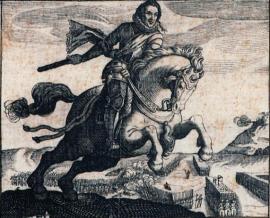
Duke of Brunswick is portrayed here while jumping on a horseback, riding to the right. The rider is not wearing a hat, has a wide sash attached across his shoulder and is holding a marshal's baton in his right hand. The portrait is surrounded by 38 depictions of the towns and fortresses conquered by Brunswick.
Signature: Not available
Autor: Killan Wolfgang, mědirytec
Original name: Christiaen Hertoch tot Brunswyk
Katalogová čísla:Collection Český Šternberk, kód: 470/113
Wilhelm Eduard Drugulin – Atlas historique Drugulin: 1559
Hans Wolfgang Singer – Allgemeiner Bildnisskatalog: 14549
Christian (the Younger), Duke of Brunswick-Wolfenbüttel, administrator of the Halberstadt Monastic Foundation (therefore also called “of Halberstadt”) was born on September 20, 1599 and died in Wolfenbüttel on June 16, 1626. He was an enthusiastic military leader and at first served in the Dutch army. Later on, he became a military assistant of Frederick, Elector Palatine, whose wife he was apparently in love with. On 20th April 1622, his troops were defeated by General Tilly at Höchst-on-th-Main, and suffered another defeat from Tilly at Stadtlon on 6th August 1623. In 1624, Brunswick waived his position of an administrator in Halberstadt and entered in the service of the Danish King Christian IV as a general. He recruited men into his army in Wolfenbüttel, to achieve at last some positive results against Tilly in 1626.
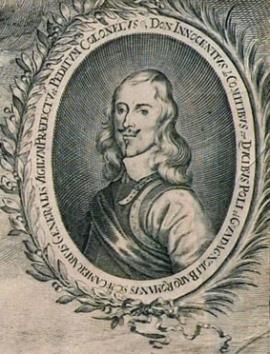
This bust portrait depicts the general as gazing to the left, with long falling hair, moustache and small goatee. He is clad in cuirass with a sash attached across. The portrait is framed with palm and laurel sprays; it was engraved by M. Merian according to the master by Ch. Skreta, and is a part of a large print with the theme of the siege of Prague by the Swedes in 1648.
Signature: Not available
Autor: Fürok Sebastian, kartograf z Frankfurtu n. Moh.
Original name: Don Innocentius de comitibus ex Ducibus Poli et Guandagnoli baro Romanus S. C. Mtis. Camerarius Generalis vigilium, prefectus et peditum colonelus.
Katalogová čísla:Collection Český Šternberk, kód: 470/113
Wilhelm Eduard Drugulin – Atlas historique Drugulin: 1559
Hans Wolfgang Singer – Allgemeiner Bildnisskatalog: 14549
Innocens Duca di Conti Guadagnolo was a son of Lothario Conti, Duke of Poli and Margrave of Piatica and his wife Julia Ursinae de Bomarzo. He was born and studied in Rome. After his father's death, Conti joined the service in the army of Ferdinand III and as a commander of the division of cuirassiers participated in the Battle of Diedenhoden (Thionville) in the army of Prince Piccolomini. In 1647 he became commander of the infantry regiment and fought in the Battle of Jihlava where he was seriously wounded. Later on Conti participated in the conquests of Krems, Kornneuburg and Opava. That same year, Conti was proposed the commander of Regensburg. In 1648 Conti happened to stay in the Old Town of Prague, when the Swedes seized the Castle and the Lesser Town. He took part in the defence of the town and in the re-conquest of the Castle. The Commander-in-Chief in Prague, the Field Marshal Count Rudolf Colloredo, rewarded Conti for his merits in service and appointed him Imperial Chamberlain and in 1649 Generalwachtmeister. As an excellent engineer he was later in charge of building of the fortification system in Prague. In 1651 Conti resigned from the imperial service and joined the Pope Innocent X, after whose death he defended Ferara against the Duke of Modena. He also accompanied the Swedish Queen Christina to Rome to the Pope Alexander II, who gave him permission to fight for the Republic of Venice against the Turks in Dalmatia. Conti died after his return to Rome towards the end of 1661.
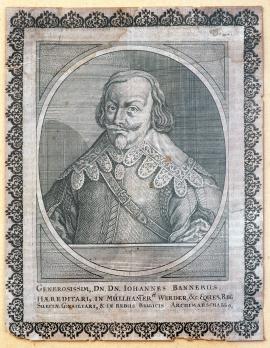
The portrait is of an oval shape. General Banner is portrayed facing forward (en face), with his moustache brushed up, a small beard, long hair falling to the shoulders and a wide lace collar. He has got a belt tightened across his arm. The oval is surrounded with a square ornamental frame. The quoted Latin inscription is placed below the picture.
Signature: Not available
Autor: Fürok Sebastian, kartograf z Frankfurtu n. Moh.
Original name: Generosissimus Dominus Dominus Johannes Bannerus, haereditarius in Müllhammer, Werder etc. Eques regii Sveciae consiliarius et in rebus bellicis archimarchallus.
Katalogová čísla:Collection Český Šternberk, kód: 444/188
Wilhelm Eduard Drugulin – Atlas historique Drugulin: 1559
Hans Wolfgang Singer – Allgemeiner Bildnisskatalog: 4811
Jan Banner, the well-known Swedish commander, was born in Djursholm nearby Stockholm on June 23, 1596, and died in Halberstadt on May 10, 1641. He excelled extraordinarily in the wars of Gustavus Adolphus against Russia and Poland, and promoted to the rank of Lieutenant General. On 7th September 1631 Banner contributed considerably to the victory of the Swedes over the imperial troops in Breitenfeld in vicinity of Leipzig, and was entrusted with the command in the south-west Germany in the autumn of 1632 already. In 1634 he was promoted to the rank of Field Marshal. He broke into Bohemia but soon had to withdraw from there due to the defeat of Bernard of Saxe-Weimar and Gustav Horn nearby Nördlingen. After the Emperor and the Saxon Elector John George I concluded peace in 1635, Banner was forced to retreat to northern Germany. However, when he reached the victory by Wittstock on October 4, 1636, he regained his dominance once again. In 1637 he was forced to retreat from Torgau to Pomerania, but in 1639 broke into Bohemia once again. During the winter of 1640-1641 Banner invaded the Reichstag in Regensburg, then chaired by Ferdinand III, from central Germany. His plan nevertheless failed, due to the sudden thaw and to the resolute action of generals Mercy and Piccolomini, who expelled the Swedes to western Bohemia and further to the north later on. Soon after that Banner became ill and died in Halberstadt. His strategic approach could be characterized by sudden and quickly performed fight actions. It was this fight method that often made him successful. His letters to the Swedish Chancellor Oxenstierna were published by Sondén in 1893.
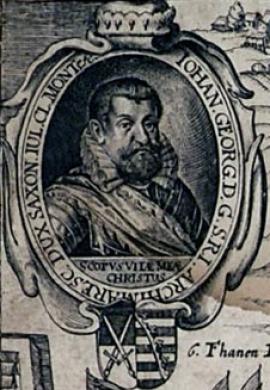
The oval portrait of the Elector of Saxony is placed in a copper engraving, depicting the conquest of Bautzen. The displayed figure is gazing to the left, has a huge beard and rather short hair cut. He is dressed in a military costume with a wide ribbon across his chest. Above the oval we can see the symbolic elector's hat. The combined coat of arms of Saxony-Meissen is displayed below the portrait.
Signature: Not available
Autor: Fürok Sebastian, kartograf z Frankfurtu n. Moh.
Original name: Johann Georg D. G. SRI Archimaresc Dux Saxoniae, Jul. Cleve, Monte.
Katalogová čísla:Collection Český Šternberk, kód: 444/188
Wilhelm Eduard Drugulin – Atlas historique Drugulin: 1559
Hans Wolfgang Singer – Allgemeiner Bildnisskatalog: 4811
Johann George I, Elector of Saxony, ruled between 1611 and 1656. He was a son of the Elector Christian I. He was born on April 5, 1585, and died on October 8, 1656. He ascended to power after his brother Christian II. His policy in course of the Thirty Years' War was marked by constant fluctuation in attitudes. Following the advice of his Lutheran court-preacher Hoe von Hoenegg, Johann George stood at the side of the Emperor in 1620, and took part in subjugation of Upper and Lower Lusatia, whose territories had been provisionally promised to him. Later, however, he diverged from the Catholics, as he felt personally aggrieved by some of the Emperor's measures, particularly by Tilly's cruel extermination of Magdeburg and by looting of the imperial troops at the Saxon territory. In 1631, the Protestant Union was established under the leadership of Hans Georg von Arnim, General from Brandenburg. The Union was supposed to guarantee to the Elector of Saxony independent position between the Swedes and the Emperor. As soon as September 1631, Johann George nevertheless became an unofficial ally of Gustavus Adolpus, and the Saxons were fighting side by side with the Emperor's enemies in the Battle of Breitenfeld. However, Saxony had never been a reliable ally. The entire formation of the Saxon troops collapsed early in the Battle of Breitenfeld and, besides that, the fleeing Saxon soldiers plundered the Swedish wagon train. After the Battle of Lützen where the King Gustavus Adolphus was killed, the ties between the Saxon and the Swedish allies chilled down and later on, John George I met with the Emperor again to conclude the Peace of Prague with him as a part of his policy on May 30, 1635 Peace of Prague. This gained him Upper and Lower Lusatia as a hereditary feud of the Czech Crown. Saxony nevertheless was not liberated from the Swedish occupation but after declaration of truce in Kötschenbroda on 27th August 1645. In 1648, the Peace of Westphalia adjudged Upper and Lower Lusatia, the Dioceses of Meissen, Merseburg, Nauburg and the Archdiocese of Magdeburg to the Saxon Elector John George I until the death of his son, who was serving as his administrator. In general, John George of Saxony kept respecting central position of the Emperor in the Holy Roman Empire throughout the Thirty Years' War despite all the differences in their attitudes and in faith.
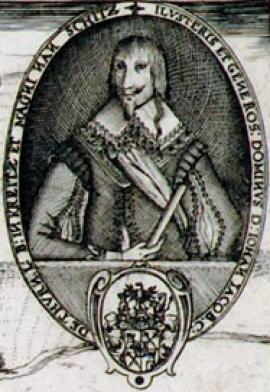
This small bust portrait in an oval field is set in the copper engraving No. 210/225. Thurn is holding a marshal's baton in his hand and is staring towards the right side. The above quoted Latin inscription is written around the oval, while the Thurn's coat of arms (depicting a tower) is placed beneath it.
Signature: Not available
Autor: Fürok Sebastian, kartograf z Frankfurtu n. Moh.
Original name: Ilustris et generosus Dominus Dominus Johann Jacob comes de Thurn, liber baro in Kreitz et Magni Nan Schitz.
Katalogová čísla:Collection Český Šternberk, kód: 444/188
Wilhelm Eduard Drugulin – Atlas historique Drugulin: 1559
Hans Wolfgang Singer – Allgemeiner Bildnisskatalog: 4811
Johann Jakob, Count of Thurn, was the son of Henry Matthias, Count of Thurn, the leader of the Czech rebellious Estates. He served in the Swedish army under King Gustavus Adolphus, where he remained even after the King's death. Johann Jakb Thurn, frequently designated as”younger” in the literature, was shot in an attempt of his troops to seize the town of Hirschberg in Silesia occupied by the imperial army in 1642.

Tilly is portrayed here in a small oval field together with the Spanish General Cordoba, in the depiction of the Battle of Wimpfen. The bust portrait depicts Tilly while staring to the right and holding a long marshal's baton. He has relatively short hair, a moustache and a goatee.
Signature: Not available
Autor: Fürok Sebastian, kartograf z Frankfurtu n. Moh.
Original name: Excell. DD. Joannes Tserclaes Baro de Tilly
Katalogová čísla:Collection Český Šternberk, kód: 444/188
Wilhelm Eduard Drugulin – Atlas historique Drugulin: 1559
Hans Wolfgang Singer – Allgemeiner Bildnisskatalog: 4811
Johann Tserclaes, Count of Tilly was born in Belgium in February 1559 and died in Ingolstadt on April 30, 1632. He received military education in the Spanish army under Alessandro Farnese, who in 1594 fought in the imperial service against the Turks. In 1610 Tilly became a commander of the army of the Catholic League and in agreement with Duke Maximilian of Bavaria built his entirely new army. In 1620 he, together with imperial troops under Buquoy, defeated the troops of the Czech Estates in the Battle of White Mountain. In the course of the subsequent war between Bohemia and the Palatinate, Tilly was defeated by Mansfeld at Wiesloch in 1622 or at Mingolsheim. Though defeated, he managed to achieve strategic advantage when joined his troops with those of Cordoba's in the battle. In the same year, he nevertheless also achieved several victories, as for instance at Wimpfen over the Margrave of Baden-Durlach or at Höchst over Christian of Brunswick-Wolfenbüttel. Tilly subsequently broke into the Lower Saxony and defeated Brunswick again at Stadtlohn. Then he fought together with Wallenstein against Christian IV of Denmark and his allies, whom they defeated in the battles of Lutter and Barnenberg in 1626. After Wallenstein's dismissal in 1630, Tilly took over command of the entire imperial army. In 1631 he conquered Magdeburg. His military achievements nevertheless came to an end once that Gustavus Adolphus appeared in the scene. In 1631 Tilly was defeated at Breitenfeld thanks to the new combat tactics of the Swedish King. He built a new army and attempted to prevent the Swedes from crossing the Lech river and from moving forward to the Bavarian territory, He was brutally defeated by Gustavus Adolphus again and, at the same time, mortally wounded nearby Rain am Lech on April 15, 1632. He died in Ingolstadt on April 30, 1632 and was buried in Altöttingen. In Tilli's person, Maximilian of Bavaria did not lose just a skilled warrior, but also a loyal and selfless comrade, whose entire estate consisted of a field baggage.

Tilly is portrayed here in a small oval field together with the Spanish General Cordoba, in the depiction of the Battle of Wimpfen. The bust portrait depicts Tilly while staring to the right and holding a long marshal's baton. He has relatively short hair, a moustache and a goatee.
Signature: Not available
Autor: Fürok Sebastian, kartograf z Frankfurtu n. Moh.
Original name: Excell. DD. Joannes Tserclaes Baro de Tilly
Katalogová čísla:Collection Český Šternberk, kód: 444/188
Wilhelm Eduard Drugulin – Atlas historique Drugulin: 1559
Hans Wolfgang Singer – Allgemeiner Bildnisskatalog: 4811
Johann Tserclaes, Count of Tilly was born in Belgium in February 1559 and died in Ingolstadt on April 30, 1632. He received military education in the Spanish army under Alessandro Farnese, who in 1594 fought in the imperial service against the Turks. In 1610 Tilly became a commander of the army of the Catholic League and in agreement with Duke Maximilian of Bavaria built his entirely new army. In 1620 he, together with imperial troops under Buquoy, defeated the troops of the Czech Estates in the Battle of White Mountain. In the course of the subsequent war between Bohemia and the Palatinate, Tilly was defeated by Mansfeld at Wiesloch in 1622 or at Mingolsheim. Though defeated, he managed to achieve strategic advantage when joined his troops with those of Cordoba's in the battle. In the same year, he nevertheless also achieved several victories, as for instance at Wimpfen over the Margrave of Baden-Durlach or at Höchst over Christian of Brunswick-Wolfenbüttel. Tilly subsequently broke into the Lower Saxony and defeated Brunswick again at Stadtlohn. Then he fought together with Wallenstein against Christian IV of Denmark and his allies, whom they defeated in the battles of Lutter and Barnenberg in 1626. After Wallenstein's dismissal in 1630, Tilly took over command of the entire imperial army. In 1631 he conquered Magdeburg. His military achievements nevertheless came to an end once that Gustavus Adolphus appeared in the scene. In 1631 Tilly was defeated at Breitenfeld thanks to the new combat tactics of the Swedish King. He built a new army and attempted to prevent the Swedes from crossing the Lech river and from moving forward to the Bavarian territory, He was brutally defeated by Gustavus Adolphus again and, at the same time, mortally wounded nearby Rain am Lech on April 15, 1632. He died in Ingolstadt on April 30, 1632 and was buried in Altöttingen. In Tilli's person, Maximilian of Bavaria did not lose just a skilled warrior, but also a loyal and selfless comrade, whose entire estate consisted of a field baggage.
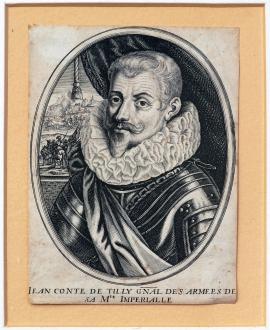
Tilly is portrayed here in an oval field from his right profile, with relatively short haircut, a rolled moustache, a fashionable goatee and a wide collar around his neck. His chest is covered with a cuirass and a sash attached across it. In the background there is a drapery with a tassel, behind which we can see a fight scene of cavalry nearby a castle. The aforementioned French inscription is placed below the portrait.
Signature: Not available
Autor: Fürok Sebastian, kartograf z Frankfurtu n. Moh.
Original name: Jean conte de Tilly generale des armées de sa majestée imperialle.
Katalogová čísla:Collection Český Šternberk, kód: 497/255
Wilhelm Eduard Drugulin – Atlas historique Drugulin: 1559
Hans Wolfgang Singer – Allgemeiner Bildnisskatalog: 90672
Johann Tserclaes, Count of Tilly was born in Belgium in February 1559 and died in Ingolstadt on April 30, 1632. He received military education in the Spanish army under Alessandro Farnese, who in 1594 fought in the imperial service against the Turks. In 1610 Tilly became a commander of the army of the Catholic League and in agreement with Duke Maximilian of Bavaria built his entirely new army. In 1620 he, together with imperial troops under Buquoy, defeated the troops of the Czech Estates in the Battle of White Mountain. In the course of the subsequent war between Bohemia and the Palatinate, Tilly was defeated by Mansfeld at Wiesloch in 1622 or at Mingolsheim. Though defeated, he managed to achieve strategic advantage when joined his troops with those of Cordoba's in the battle. In the same year, he nevertheless also achieved several victories, as for instance at Wimpfen over the Margrave of Baden-Durlach or at Höchst over Christian of Brunswick-Wolfenbüttel. Tilly subsequently broke into the Lower Saxony and defeated Brunswick again at Stadtlohn. Then he fought together with Wallenstein against Christian IV of Denmark and his allies, whom they defeated in the battles of Lutter and Barnenberg in 1626. After Wallenstein's dismissal in 1630, Tilly took over command of the entire imperial army. In 1631 he conquered Magdeburg. His military achievements nevertheless came to an end once that Gustavus Adolphus appeared in the scene. In 1631 Tilly was defeated at Breitenfeld thanks to the new combat tactics of the Swedish King. He built a new army and attempted to prevent the Swedes from crossing the Lech river and from moving forward to the Bavarian territory, He was brutally defeated by Gustavus Adolphus again and, at the same time, mortally wounded nearby Rain am Lech on April 15, 1632. He died in Ingolstadt on April 30, 1632 and was buried in Altöttingen. In Tilli's person, Maximilian of Bavaria did not lose just a skilled warrior, but also a loyal and selfless comrade, whose entire estate consisted of a field baggage.
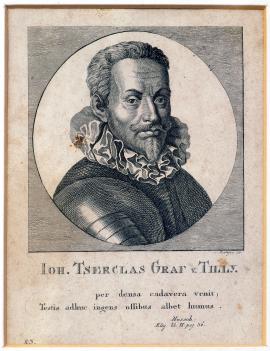
This bust portrait depicts the General from his right profile in an oval field. He is dressed in armour with a collar coiled around his neck. His name together with a Latin quotation “per densa cadavera venit, Testis adhuc ingens ossibus albet humus” are inscribed under the portrait.
Signature: Hossch. Langer sc. Eleg.lib. II. pag. 30.
Autor: Langer, mědirytec
Original name: Jean conte de Tilly
Katalogová čísla:Collection Český Šternberk, kód: 497/255
Wilhelm Eduard Drugulin – Atlas historique Drugulin: 1559
Hans Wolfgang Singer – Allgemeiner Bildnisskatalog: 90672
Johann Tserclaes, Count of Tilly was born in Belgium in February 1559 and died in Ingolstadt on April 30, 1632. He received military education in the Spanish army under Alessandro Farnese, who in 1594 fought in the imperial service against the Turks. In 1610 Tilly became a commander of the army of the Catholic League and in agreement with Duke Maximilian of Bavaria built his entirely new army. In 1620 he, together with imperial troops under Buquoy, defeated the troops of the Czech Estates in the Battle of White Mountain. In the course of the subsequent war between Bohemia and the Palatinate, Tilly was defeated by Mansfeld at Wiesloch in 1622 or at Mingolsheim. Though defeated, he managed to achieve strategic advantage when joined his troops with those of Cordoba's in the battle. In the same year, he nevertheless also achieved several victories, as for instance at Wimpfen over the Margrave of Baden-Durlach or at Höchst over Christian of Brunswick-Wolfenbüttel. Tilly subsequently broke into the Lower Saxony and defeated Brunswick again at Stadtlohn. Then he fought together with Wallenstein against Christian IV of Denmark and his allies, whom they defeated in the battles of Lutter and Barnenberg in 1626. After Wallenstein's dismissal in 1630, Tilly took over command of the entire imperial army. In 1631 he conquered Magdeburg. His military achievements nevertheless came to an end once that Gustavus Adolphus appeared in the scene. In 1631 Tilly was defeated at Breitenfeld thanks to the new combat tactics of the Swedish King. He built a new army and attempted to prevent the Swedes from crossing the Lech river and from moving forward to the Bavarian territory, He was brutally defeated by Gustavus Adolphus again and, at the same time, mortally wounded nearby Rain am Lech on April 15, 1632. He died in Ingolstadt on April 30, 1632 and was buried in Altöttingen. In Tilli's person, Maximilian of Bavaria did not lose just a skilled warrior, but also a loyal and selfless comrade, whose entire estate consisted of a field baggage.
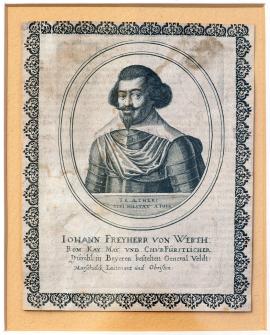
The oval portrait depicts General of Cavalry Werth en face, down to his waist. His left eye has a squint. He is dressed in a breastplate. He has got black hair, a moustache and a goatee. A Latin quotation is inscribed beneath the portrait.
Signature: Not available
Autor: Langer, mědirytec
Original name: Johann Freiherr von Werth, Röm. Kay. May. und Churfürstlicher Durchl. in Bayern bestelten Generalveldt: Marschalk Leutnant und Obristen.
Katalogová čísla:Collection Český Šternberk, kód: 502/151
Wilhelm Eduard Drugulin – Atlas historique Drugulin: 1559
Hans Wolfgang Singer – Allgemeiner Bildnisskatalog: 96041
Johann von Werth was born in Büttgen (Jülich) sometime around 1600 and died in Benátky in Bohemia on 16th January 1652. In 1630 he joined the army of the Catholic League under Tilly. After the Battle of Nördlingen in 1634, Werth was awarded for his merits the title of free lord and was appointed Field Marshal-Lieutenant (Feldmarschalleutnant). He excelled particularly in the battles against the French and in 1636 led his troops as far as to the region in close vicinity of Paris. On 3rd March 1638 he was defeated by Bernard of Saxony-Weimar in the Battle of Rheinfelden and fell into captivity. He had to wait till 1642 to be traded for the Swedish general Horn and to get released. Later he took part in the victorious Battle of Tuttlingen in 1643, fought at Mergentheim and Allerheim in 1645, but also was involved in the crushing defeat of the Imperial Army at Jankov by the Swedes under the command of Torstensson. After the death of General Mercy, the Elector Maximilian of Bavaria appointed him the supreme commander of the Bavarian troops. When the Duke of Bavaria with the Swedes and the French agreed on armistice in Ulm in 1647, Johann von Werth joined the imperial army and the Emperor granted him the title of an Imperial Count.
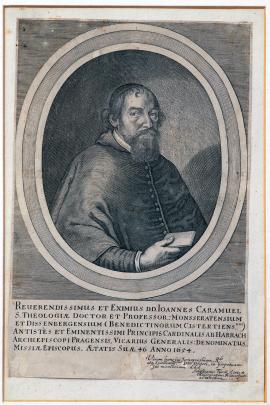
The portrait is placed in an oval field. The portrayed man looks to the right, is dressed in cassock and is holding a book in his right hand. His hair is cut short, his beard on the chin is wide, but the moustache is unobtrusive. The text mentioned above is written above the portrait.
Signature: Viram hanc sui iconographiam everendissimo atque excellentissimo domino doctori in perpetuam sui memoriam d. d. d. Sebastianus Fürck, civis et chalcographus Frankfurti ad Moenum.
Autor: Langer, mědirytec
Original name: Reverendissimus et eximius d. d. Joannes Caramuel s. Theologiae doctor et professor Monseratensium et Dissenbergensium (Benedictinorum Cisterciensum) antistes et eminentissimi principis cardinalis ab Harrach, archiepiscopi Pragensis vicarius generalis denominatus missiae episcopus. Aetatis suae 46 Anno 1654.
Katalogová čísla:Collection Český Šternberk, kód: 450/192
Wilhelm Eduard Drugulin – Atlas historique Drugulin: 1559
Hans Wolfgang Singer – Allgemeiner Bildnisskatalog: 12104
John Caramuel, occasionally written with the third name of Lobkowicz after his grandmother Regina Lobkowicz, was a son of Lawrence Caramuel, a Dutch nobleman who lived at the court of Rudolf II in Prague. He was born on 13th May 1606 in Madrid, was a prelate, a warrior, a scholar as well as a Spanish writer. He excelled in almost all scientific fields of the time. As young as 12 he already studied philology and philosophy at the Academy of Alcala, to follow with the studies of theology at the University of Salamanca. He was received into the Cistercian Order. In Leuven he acted as a professor, but he was also actively fighting against the French. He also succeeded in the political arena, mainly thanks to his manifest against the Portuguese King John of Braganza, which won him the favour of the Spanish court that appointed him the ambassador in Vienna. Soon he also won favour of Ferdinand III, which gave him the opportunity to open his career in the countries of the Holy Roman Empire. He was awarded a range of titles and distinctions. The Archbishop of Prague, Count of Harrach appointed him Grand-Vicar and engaged him in recatholisation in Bohemia. Caramuel's radical stance nevertheless soon set a conflicts of opinions in between him and Harrach. In 1648 Caramuel took part in the defence of Prague against the Swedes as a commander of a company composed of monks. Later on he went to Italy and became a Bishop of Vigevano and died here in 1682. His literary work was extremely extensive. He belonged amongst the most competent and literate personalities of his time.
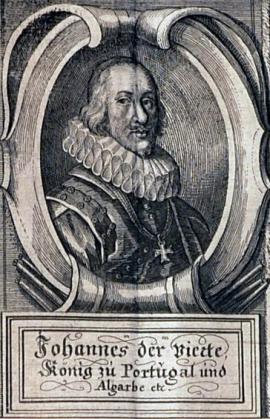
Král hledí doleva, má malý knír a nenápadnou bradku, kolem krku španělský límec. This is a bust portrait in an oval field, with a richly decorated frame. The King is gazing to the left, has a small moustache, a subtle goatee, and a Spanish collar around his neck.
Signature: Not available
Autor: Langer, mědirytec
Original name: Johannes der vierte König von Portugal und Algarbe etc.
Katalogová čísla:Collection Český Šternberk, kód: 450/192
Wilhelm Eduard Drugulin – Atlas historique Drugulin: 1559
Hans Wolfgang Singer – Allgemeiner Bildnisskatalog: 12104
John IV, King of Portugal of the house of Braganza, reigned from 1640 to 1656. He was born in Villa Viçosa on March 19, 1604 and died in Lisbon on November 6, 1656. He was the founder of the Portuguese Braganza dynasty, and extricated Portugal from Spanish domination in 1640. In 1654, he expelled the Dutch from Brazil.
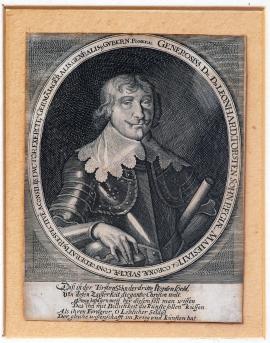
The portrait in an oval depicts the General en face. His hair is parted in the middle and he has a moustache and a pointed goatee. His chest is dressed in a breastplate with a wide lace collar at the neck. He is holding a marshal's baton in his left hand, his right hand is resting on a helmet. Six lines of text praising Torstensson's merits and virtues are inscribed under the portrait.
Signature: Not available
Autor: Langer, mědirytec
Original name: Generosissimus Dn. Dn. Leonhardus Torstensohn regiae majestatis et coronae Svecae confoederatis respective aconsiliis ductor exercitum Germaniae alis generalis et gubernator Pomerae.
Katalogová čísla:Collection Český Šternberk, kód: 499/202
Wilhelm Eduard Drugulin – Atlas historique Drugulin: 1559
Hans Wolfgang Singer – Allgemeiner Bildnisskatalog: 91003
Lennart ( Leonard ) Torstensson was born in Sweedish Forstena in 1603 and died in Stockholm in 1651. He opened his career in service at the royal court, from where he joined the army. In 1630 he came to Germany with the army of Gustavus Adolphus as a colonel of artillery and he was taken captive in 1632 during an attack on Wallenstein's camp in Nuremberg. He was released in February 1633 and afterwards fought for some time with the Swedish army in Livonia. In 1635 he reappeared in Germany, where he fought under Baner and Bernard of Saxony-Weimar. Being ill, he returned to Sweden in 1641, but soon (after Baner's death) was appointed supreme commander of the Swedish army. Though suffering a lot from gout, his combat actions were always fast and energetic. In 1642 he invaded Silesia from Saxony, defeated much stronger imperial army at Svídnice and conquered Hlohov. From Silesia he penetrated to Moravia and conquered Olomouc. He was forced out thereof by the Archduke Leopold and by Piccolomini to Saxony, but here gained bloody victory over the imperial troops in the Battle of Breitenfeld on 2nd November 1642. Then he occupied Leipzig and retreated to Frankfurt an der Oder, where he teamed up with crews from Silesia and Pomerania to invade Bohemia again in the spring of 1643. After having besieged Prague for some time, he turned to the east, freed Olomouc from the Imperial siege and settled nearby Tovačov. That same year he was nevertheless transferred with his army to Denmark, which declared war on Sweden. He managed this strategic transfer of the entire army across Germany masterfully, and shortly after seized the whole territory of Denmark except for Rendsburg and Glückstadt. The Emperor sent his troops under Matthias Gallas to Denmark to assist it, but they intervened with little significance, were driven by the Swedes as far as to the Czech border, where they remained completely inactive, exhausted and decimated after the difficult campaign in Germany. Torstensson broke into Bohemia once again and won memorably over further imperial troops under Hatzfeld, Götz and Werth at Jankov on 6th March 1645. He then moved to the Danube with the intention to team with Rakoczy and threaten the Emperor's Hereditary Lands. He besieged Brno, but the obstinate resistance of the city, the peace concluded between Rakoczy and the Emperor, an outbreak of epidemic, as well as worsening of his own disease, forced him to retreat from the Lands of the Czech Crown. Completely exhausted by his illness, Torstensson handed over the command to General Wrangel in 1646 and returned to Sweden, where he was awarded the the title of the Earl of Ortal and the post of the governor of several provinces in 1647.
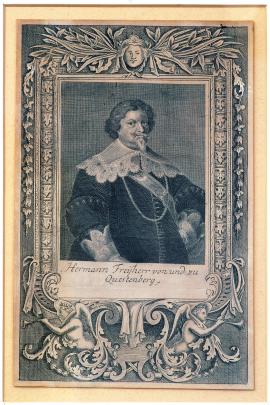
The figure is portrayed in a square field down to the waist, his left arm leaning against a sword. He is wearing dark cloths with small buttons, typical lace collar and lace cuffs. Questenberg has a moustache fashionably cut and combed upwards and a relatively long goatee. A chain is visible underneath the collar. The framing of the square field is decorated with Baroque ornamentation. The inscription of the name mentioned at previous page is located below the portrait.
Signature: Not available
Autor: Langer, mědirytec
Original name: Hermann Freiherr von und zu Questenberg
Katalogová čísla:Collection Český Šternberk, kód: 499/202
Wilhelm Eduard Drugulin – Atlas historique Drugulin: 1559
Hans Wolfgang Singer – Allgemeiner Bildnisskatalog: 91003
After his father's death (Gerhard I) in 1587, Herman Questenberg left together with his brothers their home town Cologne and settled at the court of Emperor Rudolf II in Prague. The oldest of the brothers, Kaspar eentered the clergy and became the Abbot of Strahov Monastery. The two younger brothers, Herman and Johan, let themselves employed in the court office. Matthias confirmed their common entrance into nobility by the diploma dated 28th September 1613. As an Imperial Councillor, Herman was promoted by Ferdinand II into the status of free lords in 1627 and later became an imperial minister.
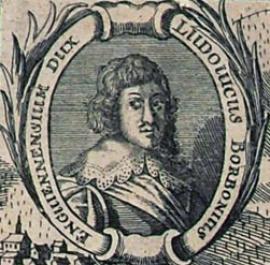
“Le grand Condé” is portrayed en face in an oval field with decorative framing. He has got long hair, a small moustache and an open neck collar. He is wearing a broad sash across his chest.
Signature: Not available
Autor: Langer, mědirytec
Original name: Ludovicus Bourbonius Enguiensium dux.
Katalogová čísla:Collection Český Šternberk, kód: 499/202
Wilhelm Eduard Drugulin – Atlas historique Drugulin: 1559
Hans Wolfgang Singer – Allgemeiner Bildnisskatalog: 91003
Louis II, Prince and Duke of Bourbon, called “the great Condé”, was born in Paris on 8th September 1621 and died in Fontainebleau on 11th December 1686. He won over the Spanish army in the decisive battle of Rocroi on 19th May 1643, together with Turenne he defeated the Bavarian General Mercy nearby Allerheim on 3rd August 1645 and he conquered Dunkirk in 1646. After the death of his father Louis II became the head of the Condé family. He defeated the Spaniards once again by Lens on 20th August 1648. During the “War of the Fronde” Condé initially took the side of Mazarin; in 1649 he besieged Pari, thus reaching return of the royal court. Soon afterwards, however, he fell into disagreement with Mazarin who had him arrested in January 1650. In the early 1651 Mazarin nevertheless had to escape from the Fronde and left Paris. Condé thus gained power and control, which he was unfortunately utterly incompetent for, due to the sternness of his completely apolitical nature. The Regent Anna called “of Austria”, with the support and advice from Mazarin, could initiate her fight against the arrogant Condé. After his victory of April 7, 1659 nearby Bleneau, Condé moved in the direction of Paris. In course of this campaign he clashed with Antoine Turenne (his former ally in the fight) and was defeated in the suburbs of the capital city on July 2 of the same year. He defected to the Spaniards and became commander of their army, eventually fighting with Turenne once again in the Netherlands. After the Treaty of the Pyrenees of 1658, Condé got rehabilitated and returned to his homeland. During the “War of Devolution” Condé conquered Franche-Comté; in the second war of Louis XIV Condé famously won by Senefu on August 11, 1674, and after the death of Turenne in 1675 took over command over the French army in Germany for a short period of time.
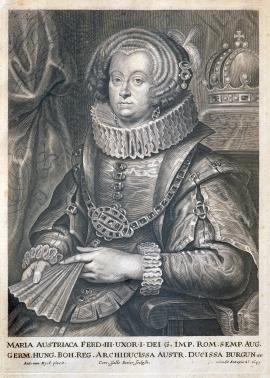
The engraving depicts the Empress while sitting in an armchair. The figure is portrayed down to her waist. She is holding a fan in her left hand and is wearing a fashionable collar in the shape of a mill-stone. Her haircut is short and curly. In the background there is the Imperial Crown.
Signature: Ant. van Dyck pinxit Corn. Galle junior sculpsit
Autor: Galle Conrad junior, holandský mědirytec
Original name: Maria Austriaca Ferd. III. uxor. I. Dei G. Imp. Rom. semp. aug. Germ. Hung. Boh. Reg. Archiducissa Austr. ducissa Burgun. etc.
Katalogová čísla:Collection Český Šternberk, kód: 476/4
Wilhelm Eduard Drugulin – Atlas historique Drugulin: 1559
Hans Wolfgang Singer – Allgemeiner Bildnisskatalog: 59621
Empress Maria Anna, the daughter of King Philip III of Spain and Margaret of Austria, was born in 1606, married in 1631, and died in 1646. She was a wife of Ferdinand III.
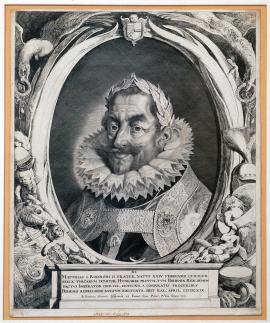
This relatively large portrait of Emperor Matthias depicts him with a laurel wreath on his head. He is dressed in a small breastplate with the crown cloak hanging loose on it, he has a collar richly decorated with lace around his neck and is decorated with the Order of the Golden Fleece. His hair is covered with the laurel wreath, moustache is fashionably combed upwards and his goatee is shaped into a narrow pointed tip. The whole bust portrait is placed into an oval field decorated with Baroque ornamentation. Above the portrait we can see a small coat of arms. The aforementioned inscription is placed beneath the portrait.
Signature: P. Soutman invenit efiigiavit et excud. cum. privil. P. van Sompel sculp.
Autor: Soutman P., malíř
Original name: Matthias I. Rudolphi II. frater, natus XXIV. Februarii CIƆILVII. Felix Turcarum dominator. Hungariae primum. Bohemiae rex demum factus imperator idib. jul. CIƆIƆCXII a conjuratis proceribus Bohemis rebelione multum excitata obit kal. April CIƆIƆCXIX.
Katalogová čísla:Collection Český Šternberk, kód: 477/273
Wilhelm Eduard Drugulin – Atlas historique Drugulin: 1559
Hans Wolfgang Singer – Allgemeiner Bildnisskatalog: 61320
Matthias I was the third son of Maximilian II. He was born in Vienna on February 24, 1557 and died in the same place on March 20, 1619. Between 1577 and 1581 he was a governor of southern provinces of the Netherlands and since 1593 of the Austrian Archdiocese. The peasant uprising of 1595 in Upper Austria was directed against counter-reformation measures. Ever -growing incapacity of Rudolf II made his cousins and brothers to wage wars against the Turks and the revolting Hungarians, and even to conclude terms of peace independently. Forced by the circumstances and his brother Matthias, Rudolf ceded his reign over Austria, Hungary and Moravia thereto in 1608, and in Bohemia in 1610 alike. After Rudolf's death on June 13, 1612 Mathias became Holy Roman Emperor. His main advisor was Cardinal Khlesl. The Emperor was attempting in vain to reconcile the Catholics with the Protestants in his lands. In 1615 Matthias was forced to conclude peace with the Turks at disadvantageous terms, as he was denied necessary funds for the war. Matthias was childless and consented with his nephew Ferdinand of Styria to be crowned the King of Bohemia (1617) and the King of Hungary (1618). His Counter-Reformation attempts in Bohemia encountered determined resistance of the Czech Protestant Estates. The controversy around the Rudolf's Letter of Majesty (1609) resulted in the Czech Estates Uprising. It was then that Matthew died (on 20th March 1619).
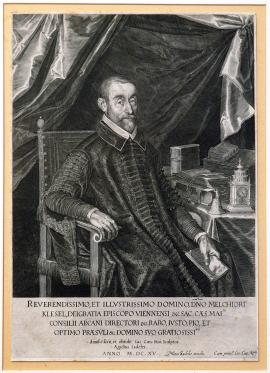
The portrait depicts Cardinal Khlesl sitting in an armchair, slightly turned to the left. His right hand is resting on the armrest, his left hand is holding a book with the inscription “Ad sac. Caes. Majtem”. Cardinal is dressed in richly embroidered cassock and has a goatee and a moustache. A watch, some books and a small bell are lying on the table nearby the figure. The background is formed of a plentifully folded drapery. The whole picture reveals Sadeler's artistic mastery.
Signature: Marco Sadeler excudit, Cum privil. Sac. Caes. Matis.
Autor: Sadeler Marco, rytec
Original name: Reverendissimo, et illustrissimo Domino, Domino Melchiori, Dei Gratia Episcopo Viennensi &c. Sac. Caes. Majestatis consilii arcani directori &c. Baro, justo, pio, et optimo praesuli &c. Domino suo Gratiosissimo demiset, fecit et obtulit Sac. Caes. Mai. sculptor Aegidius Sadeler. Anno MDCX.
Katalogová čísla:Collection Český Šternberk, kód: 468/21
Wilhelm Eduard Drugulin – Atlas historique Drugulin: 1559
Hans Wolfgang Singer – Allgemeiner Bildnisskatalog: 48033
Melchior Khlesl, acting as the Cardinal and the Minister of the Emperor Matthias since 1615, was born in Vienna in February 1553, and died on 18th September 1630 in the same place. He was born to a Protestant baker, but soon converted to the Catholic faith. In 1598, he became a bishop in Vienna, but he did not take over the management of the diocese until 1602. As of 1599, Khlesl served in the office of the Chancellor of the Archduke and later Emperor Matthias, whose accession to the throne turned Khlesl into the genuine initiator of the Emperor's policy. His attempts to reach “settlement” with the Protestants gave rise to disputes with Ferdinand II. As an opponent of the stern action against the revolting Czech Estates, the Emperor let Khlesl taken prisoner at the castle Ambras. In 1622, the Pope transferred the trial against Khlesl to Rome and a year later he was declared innocent. He returned to Vienna in 1627. His letters to the Chief Steward of Rudolf II, Adam Dietrichstein (1583-1589), were published by Bibl in 1900.
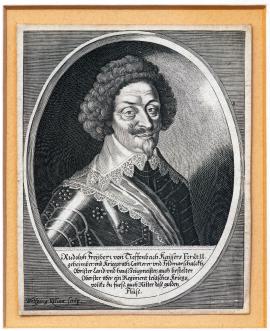
This bust portrait in an oval field depicts the General from his right profile. He has a typical moustache combed upwards, a pointed goatee and wavy hair. His nose is distinctly long. His chest is covered with a breastplate and traversed with a sash. He has a wide collar decorated with lace. The inscription quoted above is placed above the portrait.
Signature: Wolfgang Kilian sculp.
Autor: Killan Wolfgang, mědirytec
Original name: Rudolf Freiherr von Tiefenbach Kaysers Ferdt. II. geheimber und Kriegsrath, Cammerer und Feldmarschalkh, obrister Land- und Hauszeugmeister, auch bestellter Oberster über ein Regiment teutsches Kriegsvolcks zu Fusz auch Ritter des goldenen Flusz.
Katalogová čísla:Collection Český Šternberk, kód: 491/225
Wilhelm Eduard Drugulin – Atlas historique Drugulin: 1559
Hans Wolfgang Singer – Allgemeiner Bildnisskatalog: 90603
Rudolf, Lord of Tauffenbach, was born in 1582 and died in 1653. He descended from an ancient Austrian Protestant family, which supported Matthias against Rudolph II. In 1619 he was appointed in the rank of Colonel-Major of the whole imperial infantry troops and in 1620 excelled as the commander of the right wing of the imperial army in the Battle of White Mountain. Later on he fought against Bethlen in Moravia and Austria. It was not until 1623 that he converted to Catholicism and together with his troops supported Dietrichstein's Counter-Reformation in Moravia. After Wallenstein's dismissal, Tauffenbach was appointed a field marshal and was assigned to the army of Tilly. After the Battle of Breitenfeld he left for Bohemia and fought against the Saxons under the command of General Arnim. Towards the end of 1631, he nevertheless ceded the command to Wallenstein called by the Emperor once again. In 1634 he took part in the Battle of Nördlingen side by side with Archduke Ferdinand and with Gallas, but later limited his activities only to those of one of the four military counsellors at the court of the Emperor.
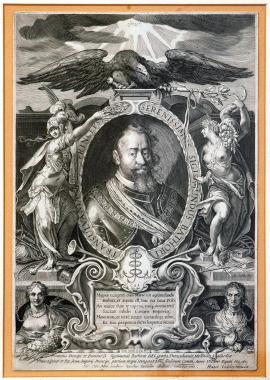
The bust portrait of Prince Báthory is placed in an oval frame surrounded with a Latin inscription. The portrait is set in a range of allegorical decorative elements of all kinds: an eagle with sword and sceptre decorated with laurels on top, the sky with clouds and beams above. A shield with an anchor reading: “scio cui credidi” is placed below the portrait. Further below there is a square cartouche with an inscription extolling the Prince's qualities in superlatives. The allegorical depictions of evil spirits are tied beside the cartouche.
Signature: Eg. Sadeler fecit Marco Sadeler excudit Sac. Caes. Maj. sculptor Egidius Sadeler dedicat 1607.
Autor: Sadeler Marco, rytec
Original name: Transsulvaniae etc. princeps etc. serenissimus Sigmundus Bathori.
Katalogová čísla:Collection Český Šternberk, kód: 445/7
Wilhelm Eduard Drugulin – Atlas historique Drugulin: 1559
Hans Wolfgang Singer – Allgemeiner Bildnisskatalog: 5338
Sigismund Báthory, Prince of Transylvania, the son of Prince Christopher, was born in 1572, married with Constance, Archduchess of Austria-Styria, on August 6, 1595, and died on March 27, 1613. Báthory conquered Wallachia in 1595, ceded Transylvania to the Emperor Rudolf II in 1598, to return soon and pass the reign on his cousin Andrew. When Andrew died in 1601, Sigismund took over the rule again, but was forced to flee to Bohemia in 1602. During his exile in Bohemia he was portrayed by Sadeler, working as an artist and painter with the court of Rudolph II in Prague.
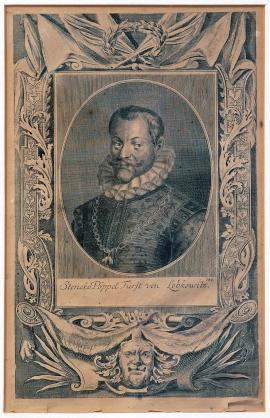
The portrait is placed in an oval field framed with various allegorical decorations. Zdenko Adalbert of Lobkowicz is portrayed en face, glancing slightly to the right. He has a moustache fashionably combed upwards and a narrow pointed goatee. Under the wide collar in the shape of a mill-stone protrudes the Order of the Golden Fleece, awarded to Lobkowicz by the Emperor.
Signature: Not available
Autor: Mierevelt M., nizozemský malíř
Original name: Stenko Poppel Fürst von Lobkowitz
Katalogová čísla:Collection Český Šternberk, kód: 471/9
Wilhelm Eduard Drugulin – Atlas historique Drugulin: 1559
Hans Wolfgang Singer – Allgemeiner Bildnisskatalog: 18413
Zdenko Adalbert, Prince of Lobkowicz, was born on 15th August 1568. He studied at the Prague University, travelled to many countries and acquired extraordinary education. His personal skills soon brought him into the high clerical positions in the imperial service. On November 13, 1603, he married Polyxena von Perstejn, widowed Rosenberg, who owned large estates. He became Chancellor of the Kingdom of Bohemia. He stuck with the policy marked with strongly Catholic and Counter-Reformation tendencies that dominated completely at the imperial court, and the Emperors he was serving to trusted him utterly. In 1621 Ferdinand II decorated him with the Order of the Golden Fleece, in 1623 he was awarded the title of an Imperial Prince and in 1624 received the same title for the Kingdom of Bohemia. He never received any land or estates from confiscations after the Battle of White Mountain, which was rather unique, considering his strong influence. His wife Polyxena nevertheless was not as “magnanimous” as Lobkowitz and the omission allegedly became a matter of conflicts between the spouses. He died on 16th June 1628 in Vienna and was buried in Capuchin Monastery in Roudnice.































































